Configuring and Formatting a Map
Choropleth map
Choropleth maps allow you to display quantitative values encoded using a color scale.
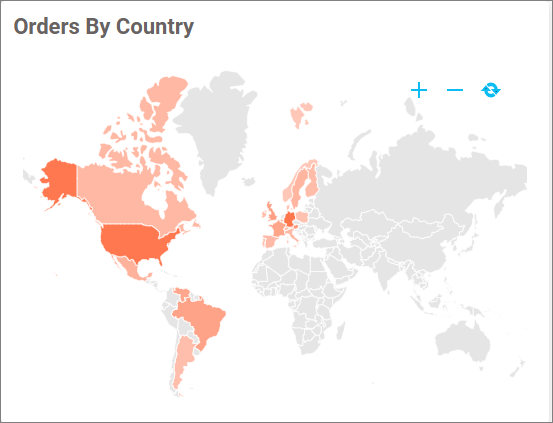
Bubble map
Bubble maps allow you to showcase quantitative values encoded using bubble size.
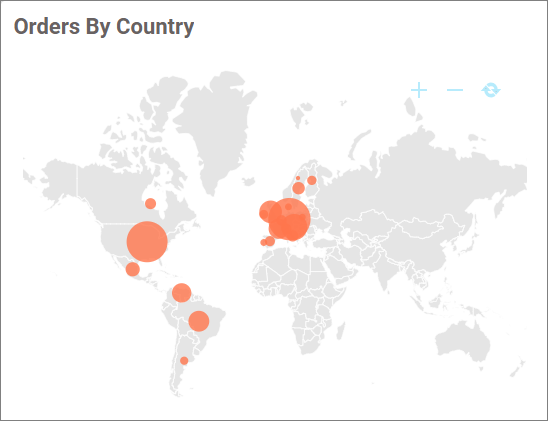
How to change map type as choropleth or bubble?
You can change the map type to choropleth or bubble by using the Map Type property.

How to configure the table data into a map?
To plot a map, you need a minimum requirement of 1 value and 1 shape. Dropping a dimension will display each region split by each of its items.
The following steps explain the data configuration of a map:
- Click on the
Data Sourcein the configuration panel.
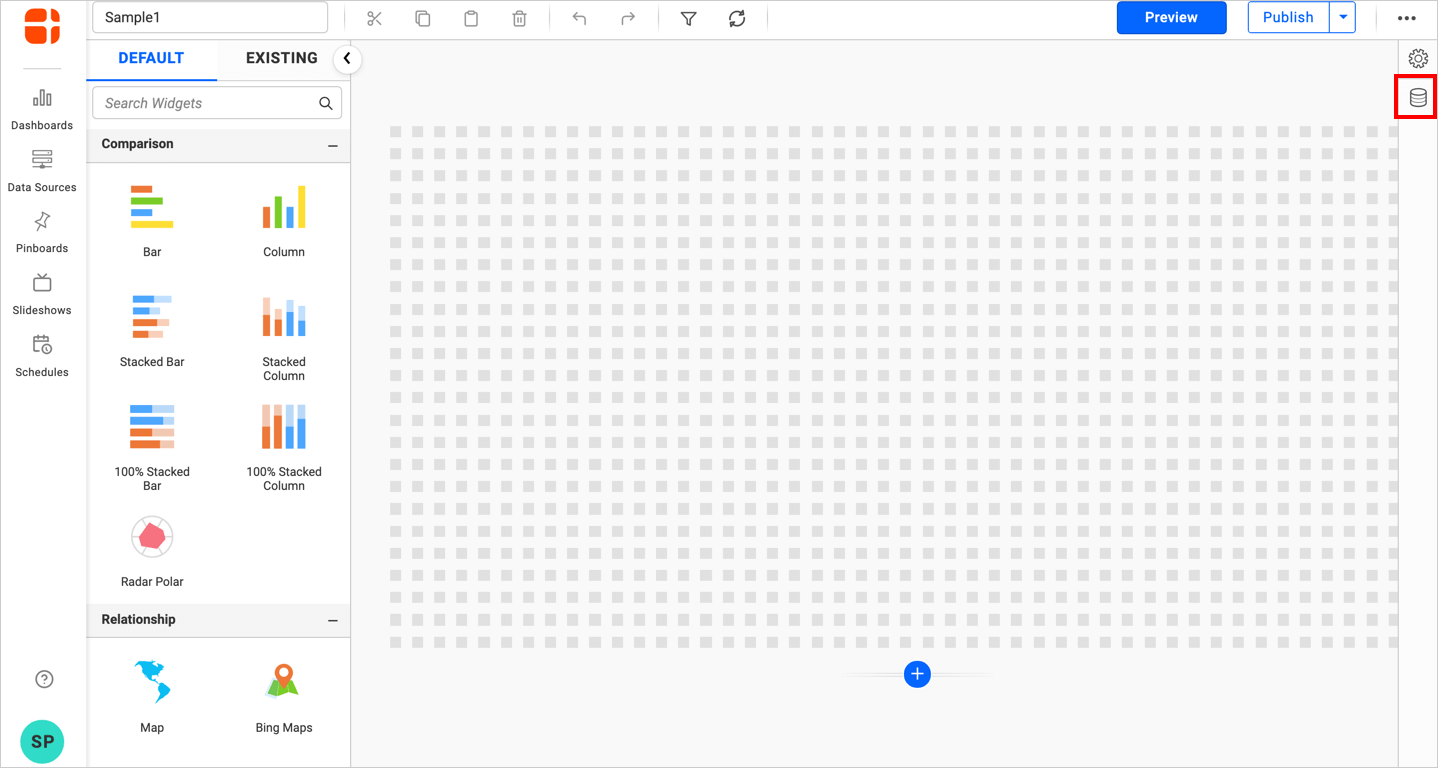
- Click on
CREATE NEWto launch a new connection from the connection-type panel.

- In the connection-type panel, click on any one of the listed connection type buttons (Here, the
Microsoft ExcelConnection type is selected for demonstration).

- In the
NEW DATA SOURCEconfiguration panel, fill in the connection type and related details. Click onConnect.
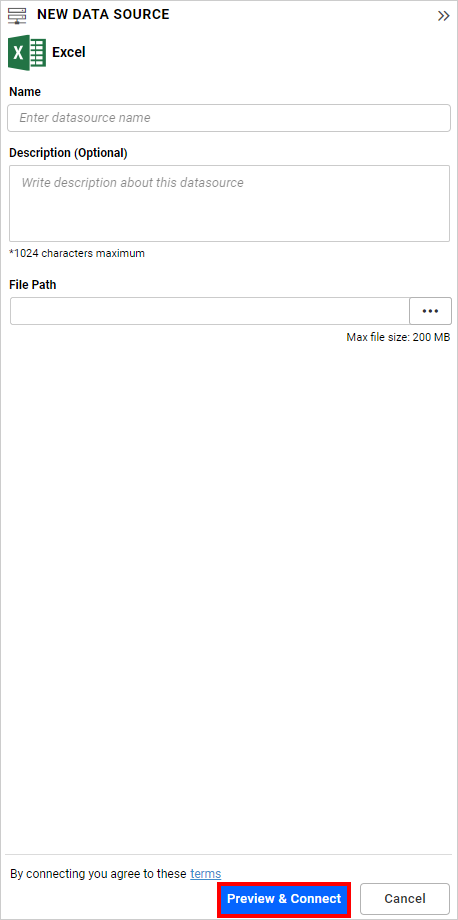
- Drag your preferred table or view from the left pane in the data design view and click
Save.

- Drag the
Mapcontrol icon from the toolbox into the design panel. You can find the control by searching in the toolbox.

- Click on
Propertiesin the configuration panel to open the property pane. Switch to theASSIGN DATAtab.
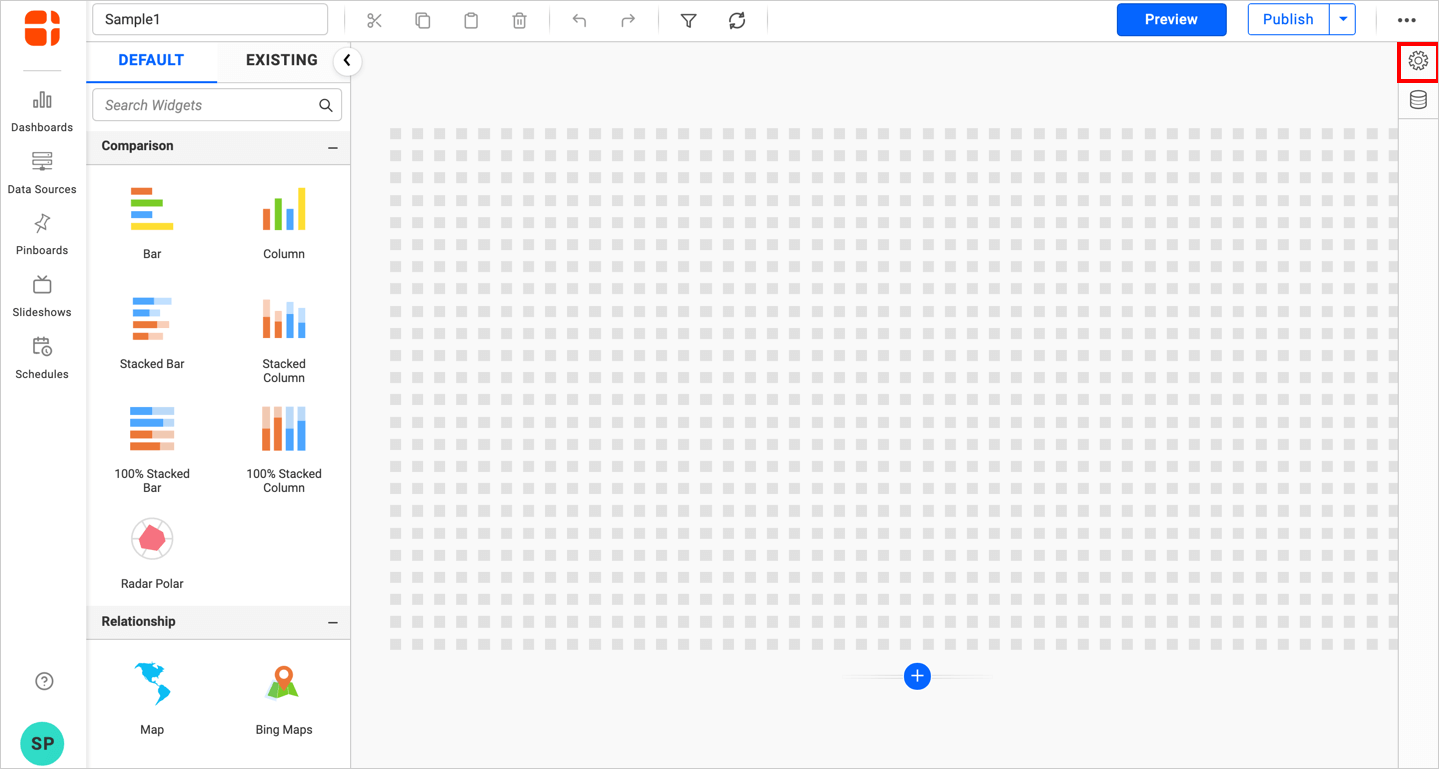
The property panel will render as follows.

click on the Assign Data.
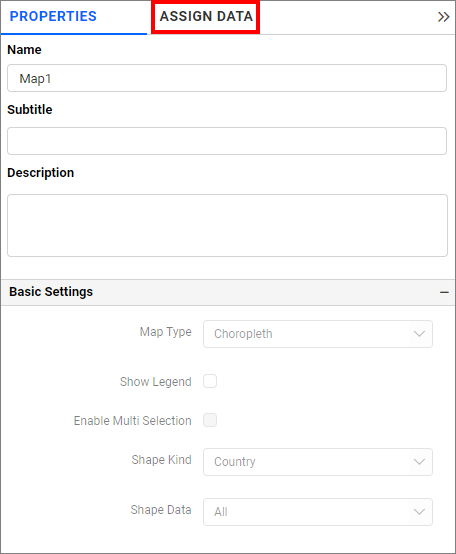
The data tab will be opened with available measures and dimensions from the connected data source.
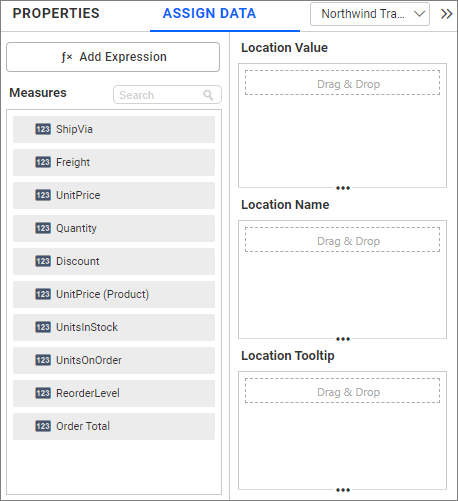
Bind columns by dragging the element from the Measures section to Location Value.

Drag the elements from the Dimension section to Location Name.
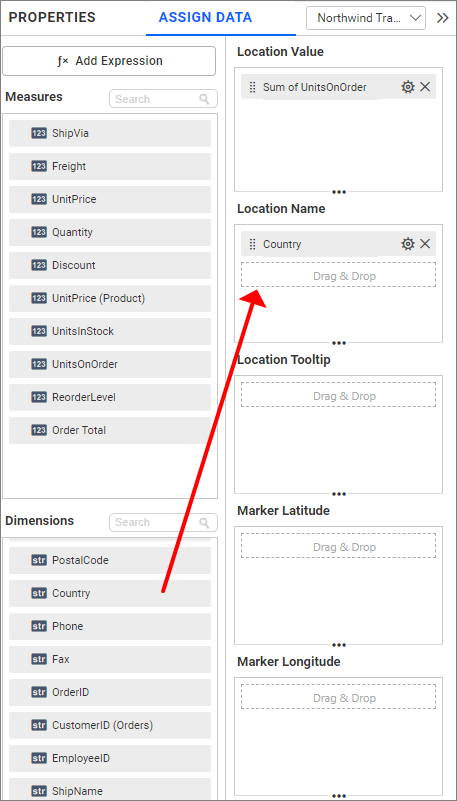
You can use the aggregation function to change the Location Value of the column.

You can use the filter to filter the data. For more details, refer to this filter.
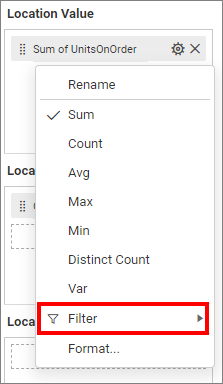
You can format the values by selecting the Format option. For more details, refer to the measure format.
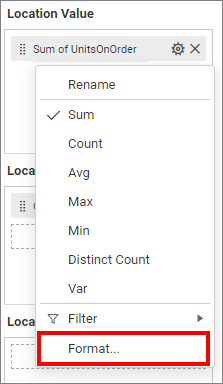
You can use the Filter(s) option to filter the data. For more details, refer to this filter.
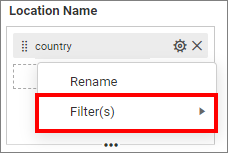
You can clear the filters by selecting the Clear options.
You can add more than one value to the Location Name field. The alert message will be shown to enable the drill-down option. Click Yes to enable the option.
NOTE: If you click
No, a single value will be added to theLocation Namefield.
Here is an illustration,
Choropleth map

Bubble map

There is a section called Location Tooltip, which is used to show the values of bound columns while rendering tooltips in a map widget.
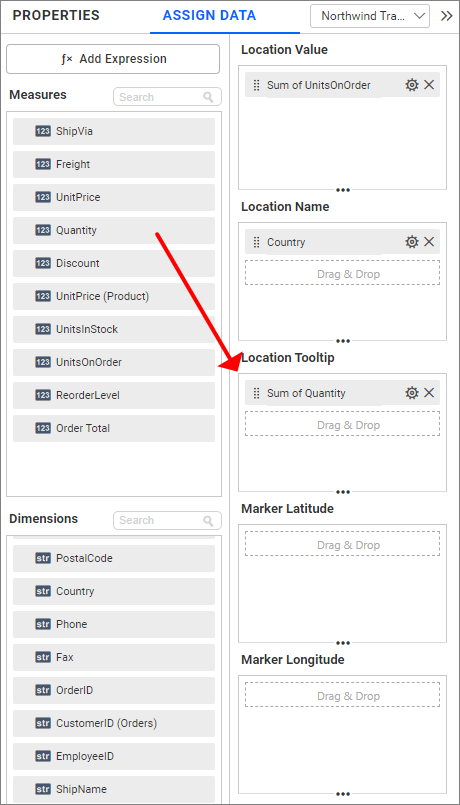
Here, this value comes with a tooltip.
Choropleth map
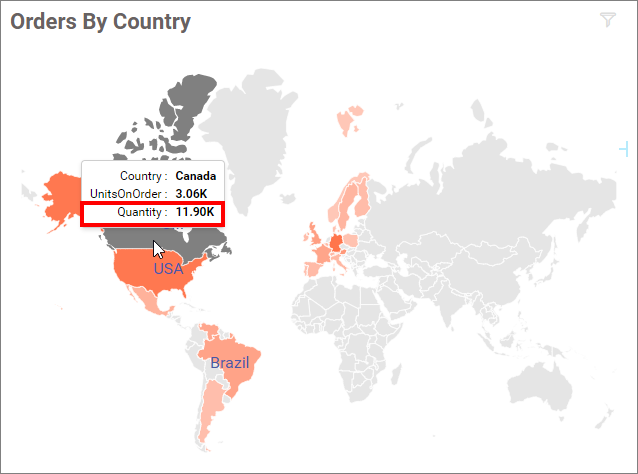
Bubble map
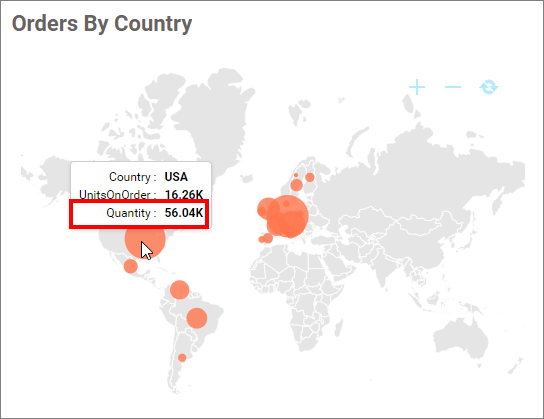
You can render markers with Marker Latitude and Marker Longitude data.
Bind columns by dragging the element from the Measures or Dimension sections to Marker Latitude and Marker Longitude. This section allows both Measures and Dimensions. To render markers, both Marker Latitude and Marker Longitude sections should have data.
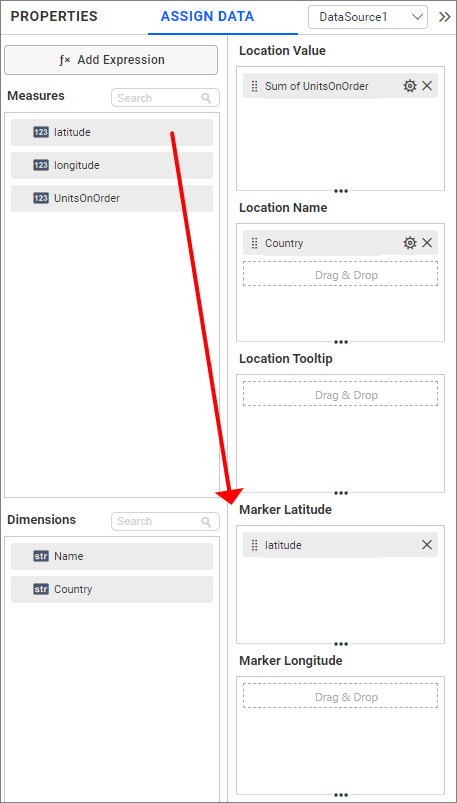

The map renders as follows.
Choropleth map
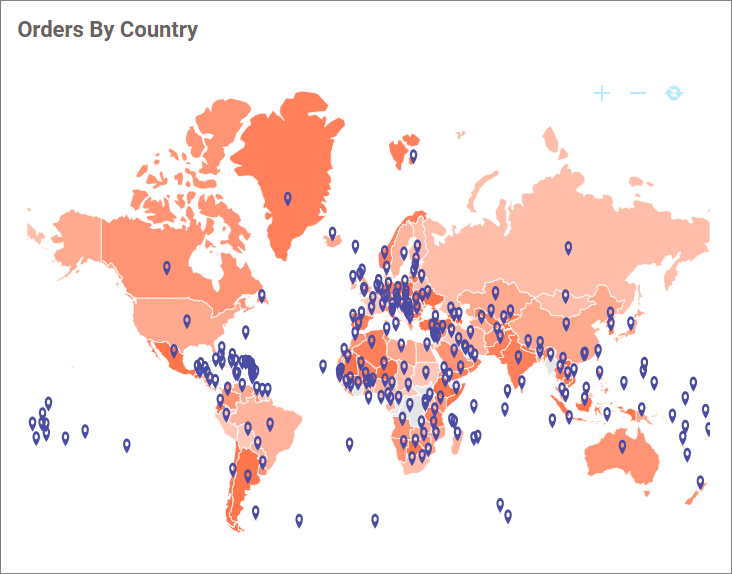
Bubble map
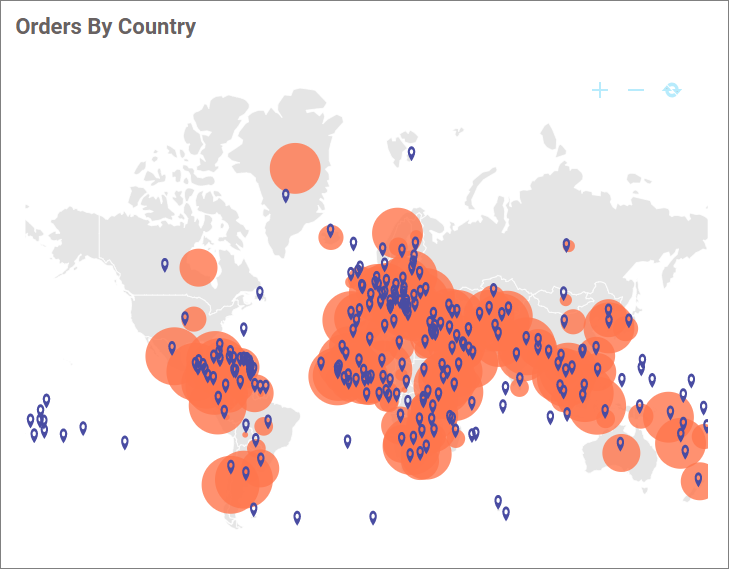
Each marker has an individual tooltip. Bind data to a Marker Tooltip from the Measures or Dimensions sections.
Marker Size
If you wish to modify the size of the marker according to the data, then you can configure that data in the Marker Size section. You can only configure the measured field for Marker Size.
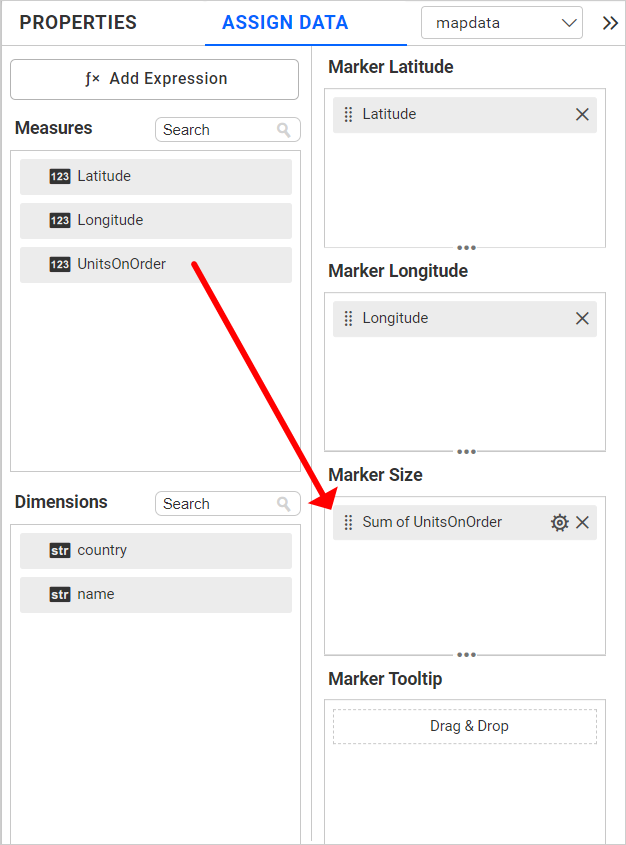
After configuring the marker size field, the map renders as follows:
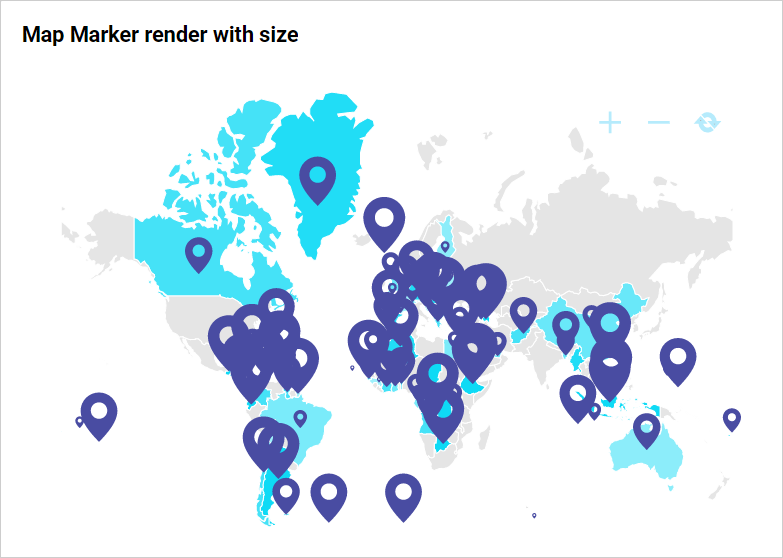
Note: After configuring the marker size, the width and height of the marker settings under the property panel will be disabled automatically.
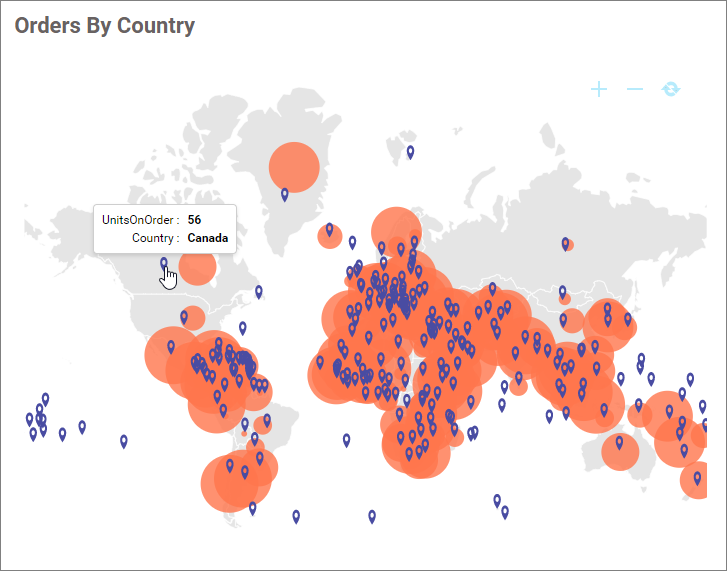
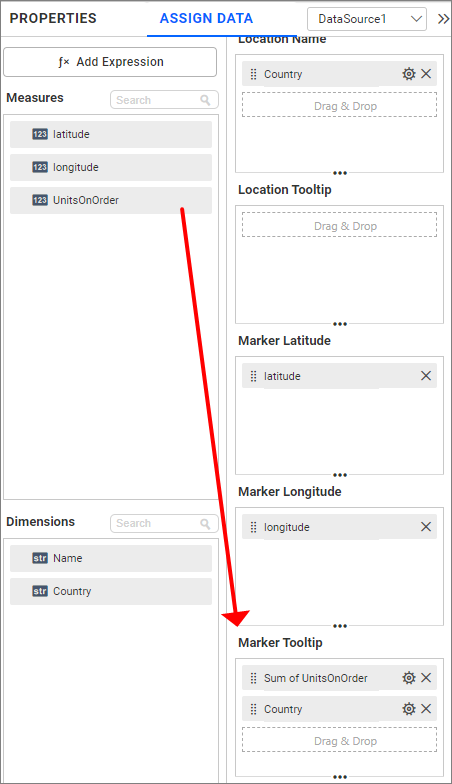
You can use the aggregation function to change the column bounds in the Marker Tooltip from the Measures section.
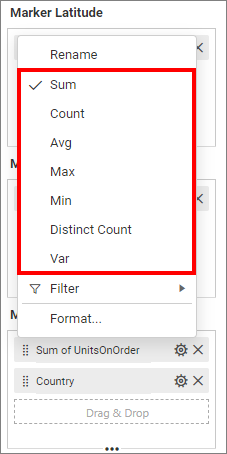
To filter the data, you can use the Filter option for both Measure and Dimensions field data. For more details, refer to this filter.
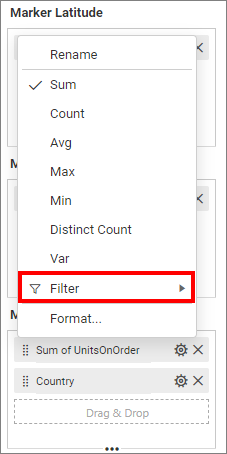

You can format the values by selecting the Format option for Measure field data. For more details, refer to the measure format.
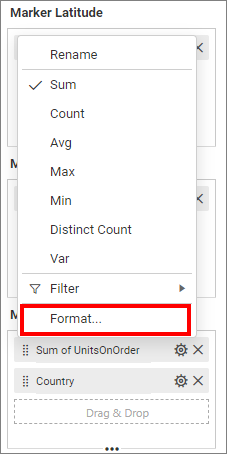
Here, the marker tooltip shows data while the cursor hovers over the marker.
Choropleth map
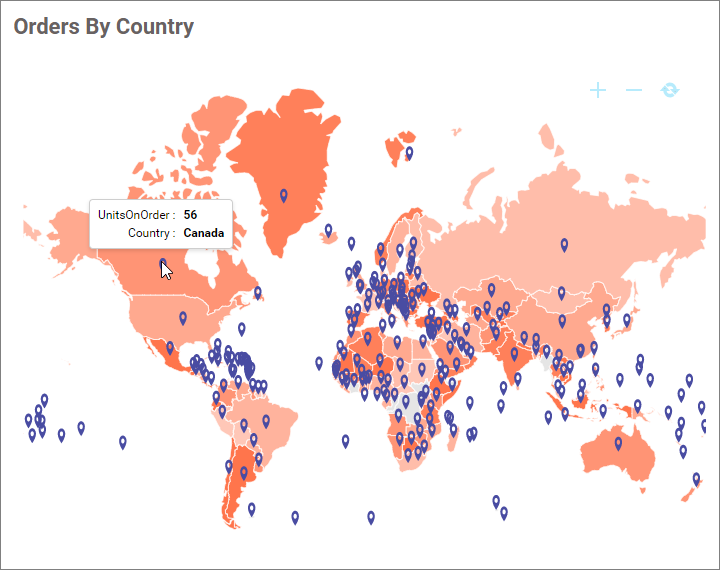
Bubble map

Hidden Column
Hidden columns are useful when we don’t want certain fields to be part of the visualization, but only used for linking, filtering and view data.
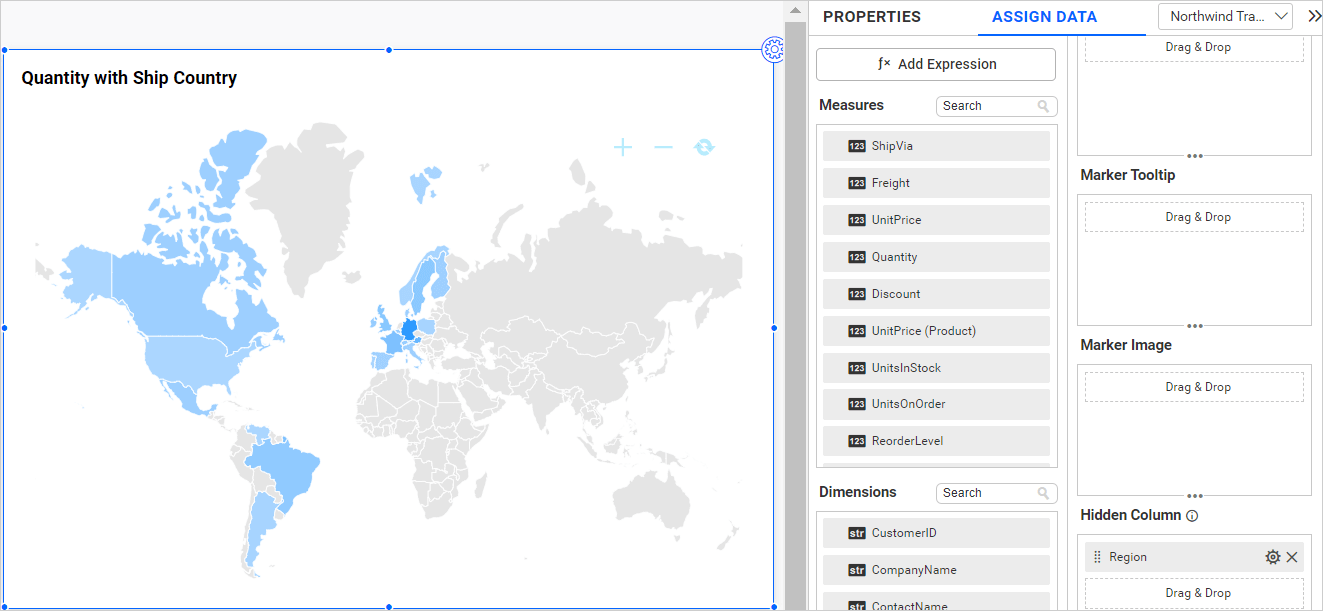
We can configure both measure and dimension fields into the hidden column. For measures, we have all the settings available except for formatting and filtering.

For dimension fields, we only have the following options.

Linking
Linking is the primary use case for hidden columns. When configuring hidden columns, the fields are listed in the linking section. By configuring a column in linking, we can pass the corresponding column value in the linking parameter.
Measure Based Example: If we want to pass the number of UnitsInStock as a URL parameter without influencing the visualization, we can configure UnitsInStock in the hidden columns and incorporate it into the link.
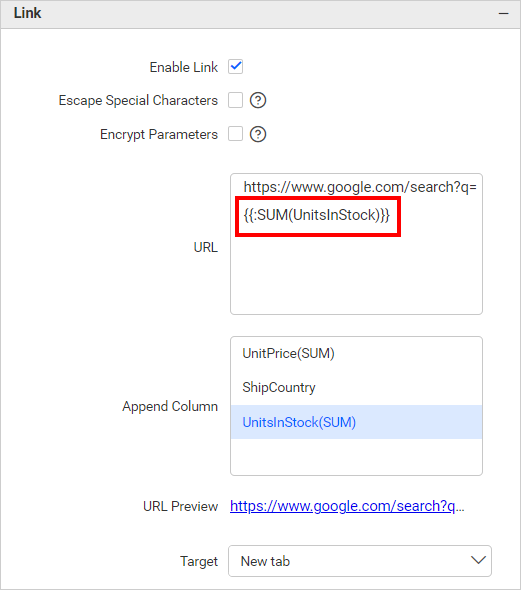
Dimension Based Example: If we want to pass the region as a URL parameter without influencing the visualization, we can configure the region in the hidden columns and incorporate it into the link.
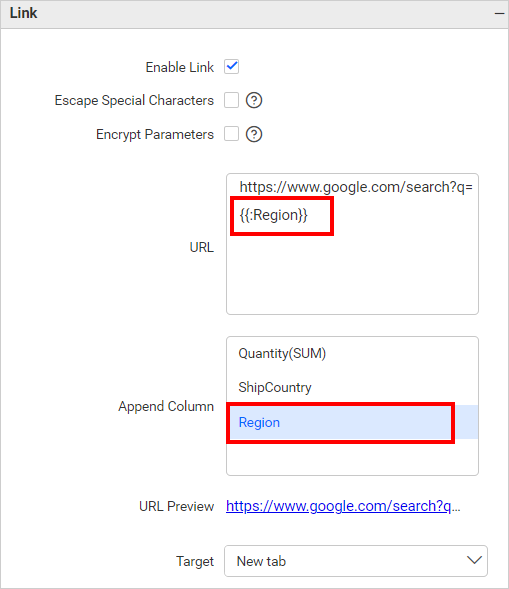
Filtering
You can use hidden columns to filter data in the visualizations. Configure hidden columns and click the below filter icon.
![]()
Click on the Custom button highlighted in the filter configuration dialog image below. It will display a list of all the fields that are configured in the widget. Keep the field that is configured in the hidden column and remove the other fields. Then, click on the Update button.

Now, in the image below, we can see that the data is filtered based on the field in the hidden column instead of the actual column that we bound in the widget.

For more details about filtering the widget data, refer to the Cross Filter Configuration documentation
View Data
You can view the data in the hidden columns in the underlying data view. This is useful for checking the data in more detail and can help you identify any issues with the data.
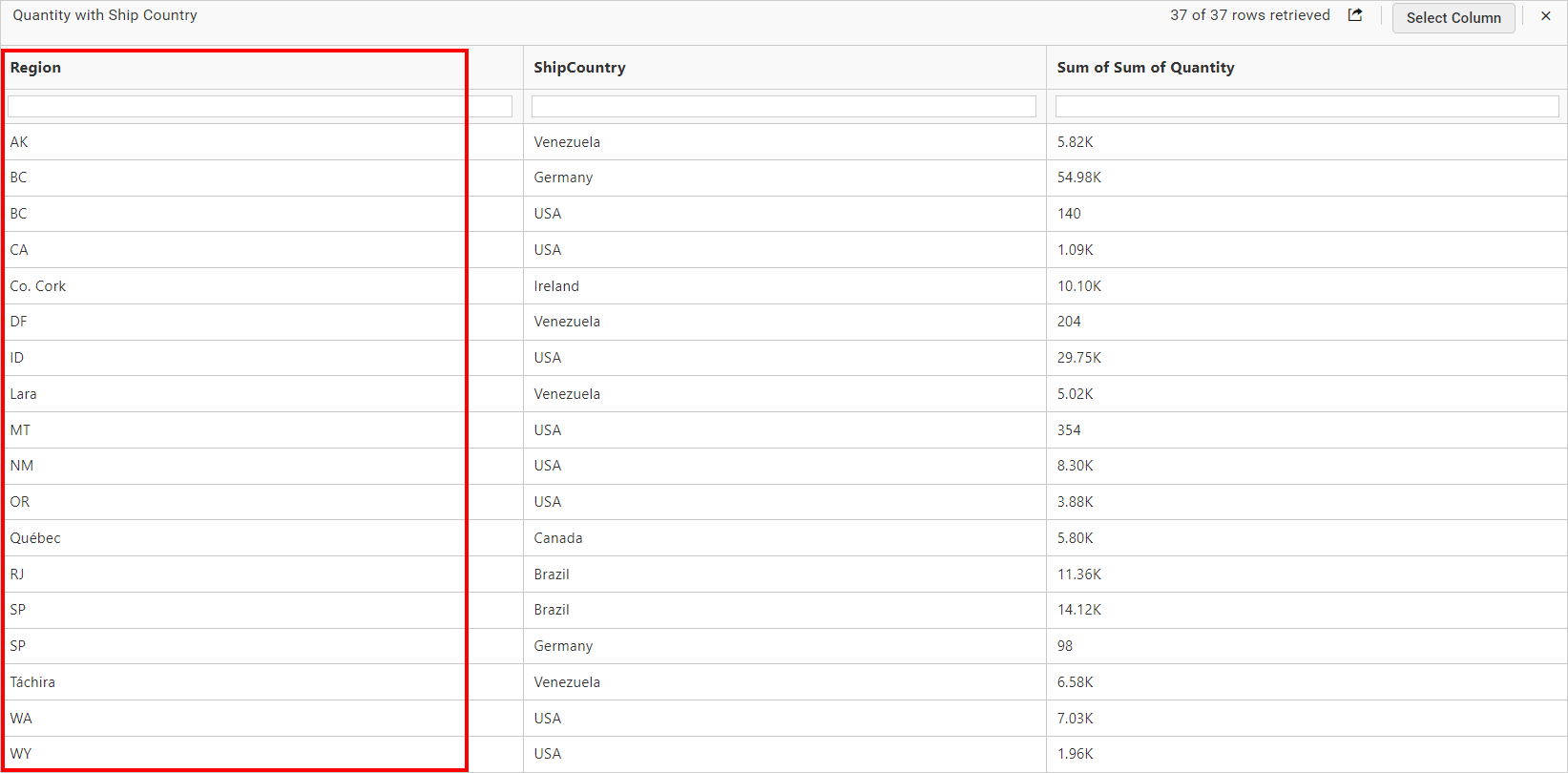
NOTE: We do not recommend configuring lower hierarchy data in hidden columns, as indicated by the info icon in the
Hidden Columnsection.
![]()
The map below displays the unit price by ship country without hidden columns.

If we configure lower hierarchy data (Ship City) in hidden columns, the data configured in the widgets gets duplicated, and incorrect data is displayed in the tooltip, as shown in the image below.

How to format a map?
You can format the map for a better illustration of the view that you require using the settings available in the Properties tab.
General Settings

Name
This allows you to set a title for the map widget.

Subtitle
This allows you to set a subtitle for the map widget.
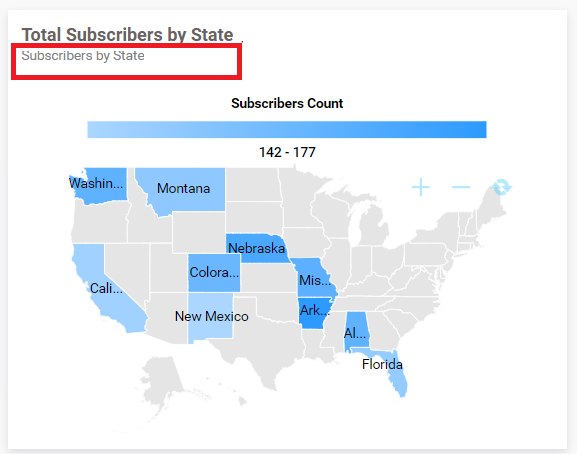
Description
This allows you to set a brief explanation about the map widget.
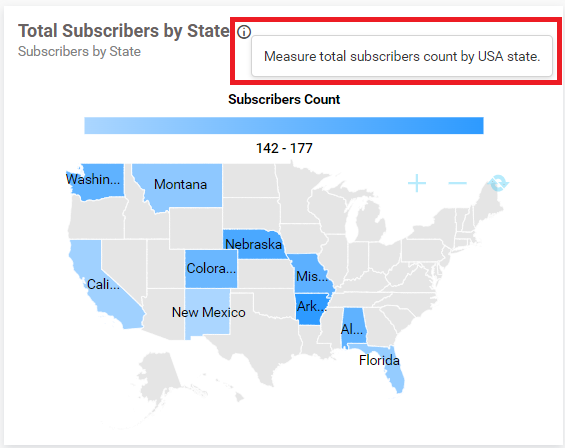
Basic settings
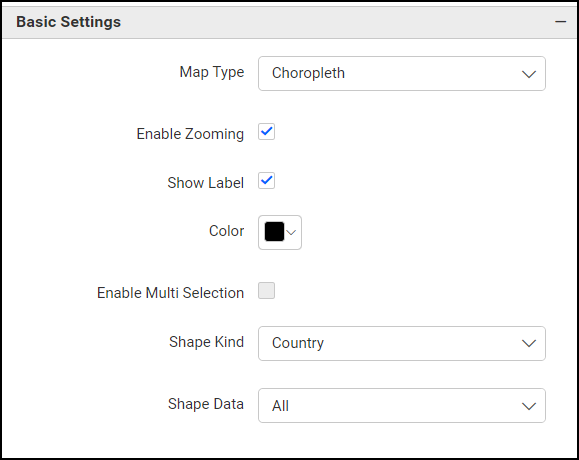
Show Tooltip
This option allows you to toggle the visibility of the tooltip in a map.

Map type
You can choose the map type as choropleth or bubble map.
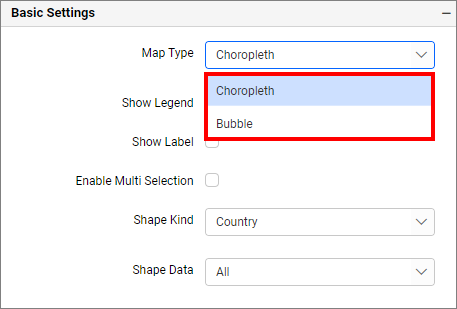
By setting the map type as Bubble, the show value label property will be hidden.
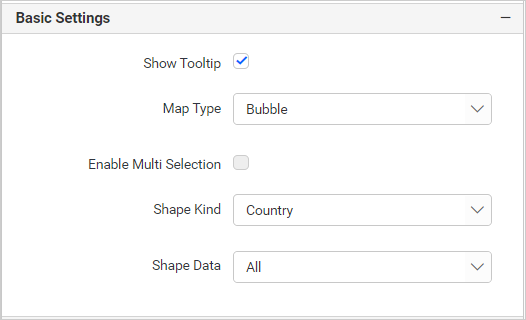
Show legend
A legend is a text used to describe the plotted data. It allows you to toggle the visibility of the legend in the map.
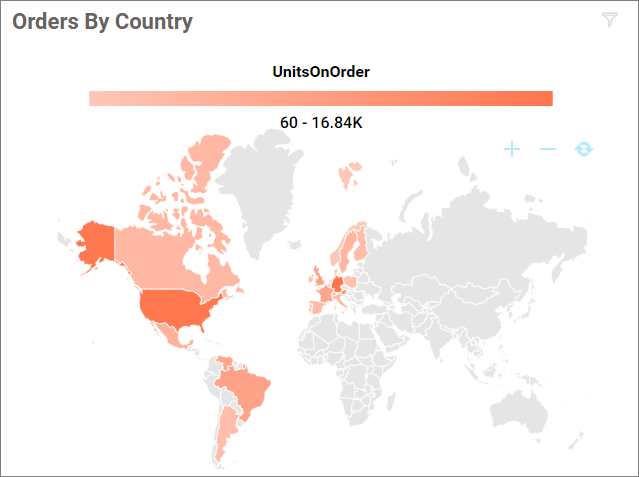
Enable Zooming
This allows you to toggle the visibility of zooming buttons.

Show Label
This allows you to enable the visibility of Data Labels.
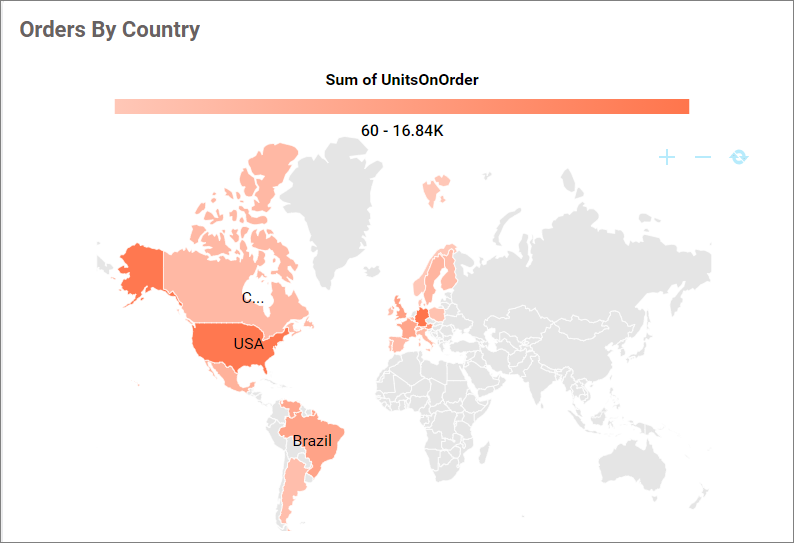
Label Color
This allows you to customize the color of the data labels.

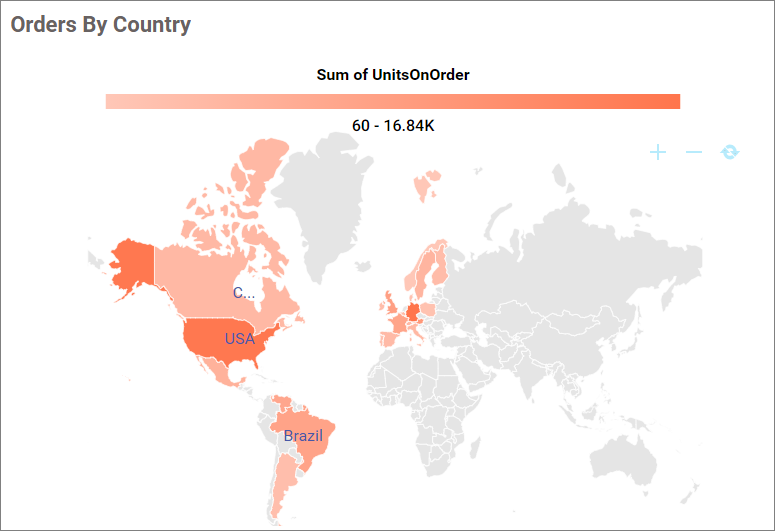
Enable Multi Selection
This option will only be enabled after you enable the Act as Master Widget option, and it allows you to filter multiple data by enabling the Enable Multi Selection option.

Shape kind
You can select any type of shape (country, continent, or state) from the shape kind drop-down.
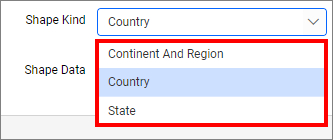
Shape data
You can choose a shape for the selected country, continent, or state. The combo box data is based on the selected values in the shape Kind.
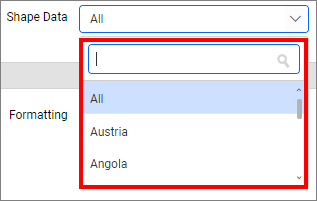
How to add new shape files
If you want to load new map shape files into the map, for example, if you wish to load the India shape file with district split-ups instead of states, follow these steps:
-
Download the India map shape file with district split-ups from any open-source website.
-
Convert the downloaded shape files to
GeoJSONformat using any open-source tool. -
Extract the downloaded shape file folder and rename to
customindia.js. Ensure that the file name is in lowercase and spaces are replaced with underscores (e.g.,south_africa.js).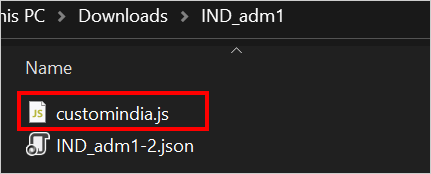
-
Open the
customindia.jsfile and add the following text at the beginning:ejdashboard.Customindia =and then save the file.
-
Copy this
customindia.jsfile and paste it into theapp_data/bi/shapefilespath.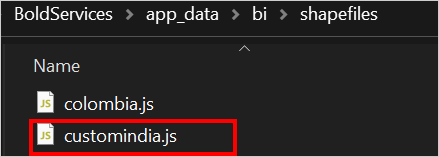
-
Next, add the customized shape name to the
shapefile.jsonfile. Thetextis only for display purposes, and thevalueshould be similar to the shape file text (e.g., the value should beCustomindiaif we use theejdashboard.Customindiaas the starting text). -
The shape file name should be added based on the shape kind. For example, since India is a country, the shape name should be added to the country collections in the JSON file.
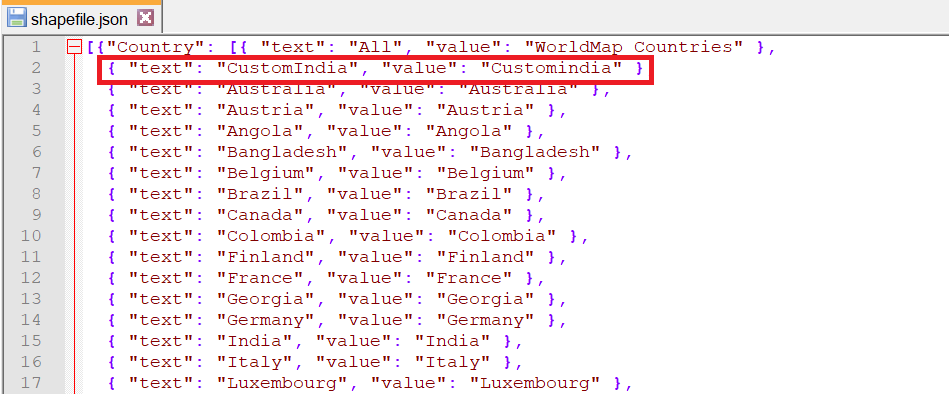
-
Reload the dashboard page and go to the property panel. Now, you should see the customized shape name that we added in the
shapefile.jsonin the shape data dropdown. If you don’t add the shape name to theshapefile.jsonfile, the shape name will not be listed in theshape datadropdown.
-
Click on the shape name and the customized shape will be rendered in the map widget based on the data configuration.
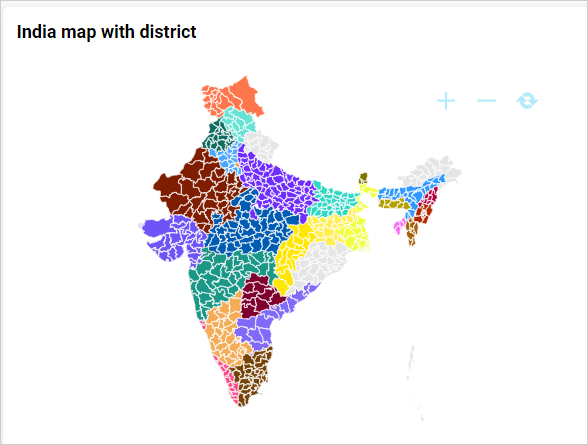
Drill down configuration
By default, the state shapes in India are divided into districts. However, if you prefer to drill the state shapes with city divisions instead of districts (e.g., if you want to drill the shape of Tamil Nadu with city divisions instead of districts), follow these steps:
-
Download the
Tamil Nadushape file with the city division from any open-source website. -
Convert the downloaded shape files to the
GeoJSONformat using any open-source tool. -
Extract it and rename the file to
customindia_tamil_nadu.js. Ensure that the file name is in lowercase and spaces are replaced with underscores (e.g.,south_africa.js).
-
Open this file and add the following text at the beginning:
ejdashboard.Customindia_Tamil_Nadu =and then save the file.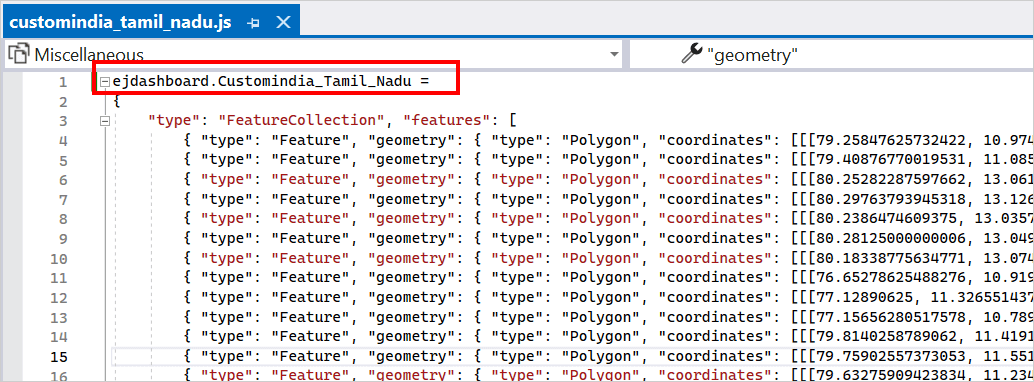
-
Include this file name into
India.jsfor drill down. Open that file and search forTamil Nadu. Then, go to the end of that line and change this text:"shapeName":"Customindia_Tamil_Nadu"instead of"shapeName":"India_Tamil_Nadu".
-
Save this file. Then copy this file and paste it into the
app_data/bi/shapefilespath.
-
Please reload the dashboard page and drill the India shape in the world map. Then drill the
Tamil Nadushape in India. TheTamil Nadushape will be displayed with city divisions instead of districts.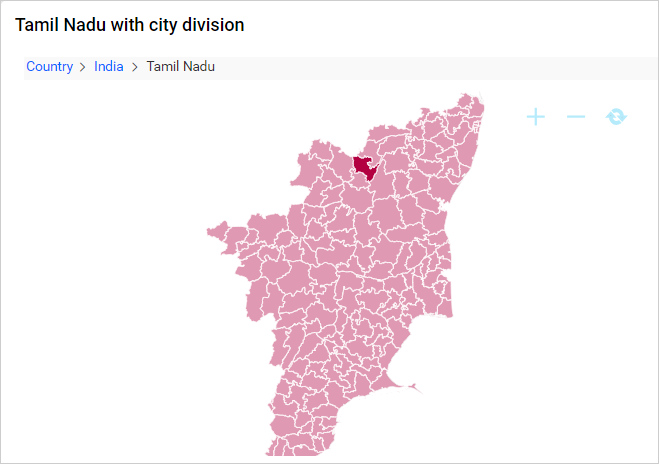
-
To load only the
Tamil Nadustate with city divisions, you need to include the shape file name in theshapefile.jsonfile. Add the shape file name to the state collections in the JSON file, asTamil Naduis a state.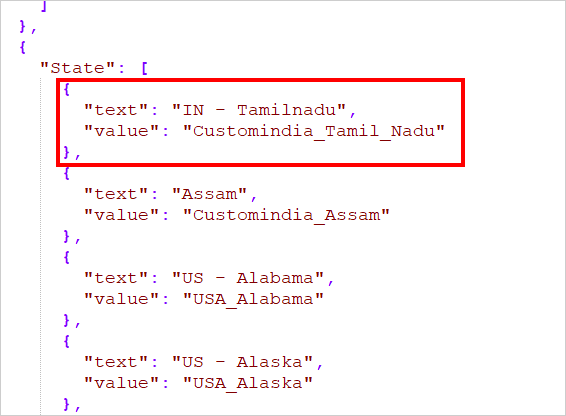
-
After adding the shape file name, reload the dashboard page and go to the property panel. Change the shape kind based on the shape name you added in the
shapefile.jsonfile. Now, the customized shape name should be visible in theshape datadropdown. If the shape name is not added to theshapefile.jsonfile, it will not appear in the shape data dropdown.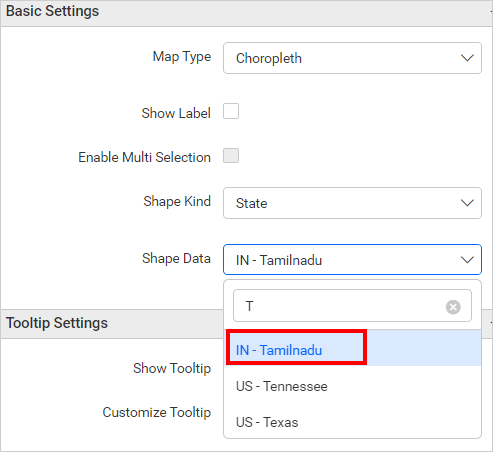
-
Once you see the customized shape name in the dropdown, click on it, and the customized shape will be rendered on the map widget based on the data configuration.
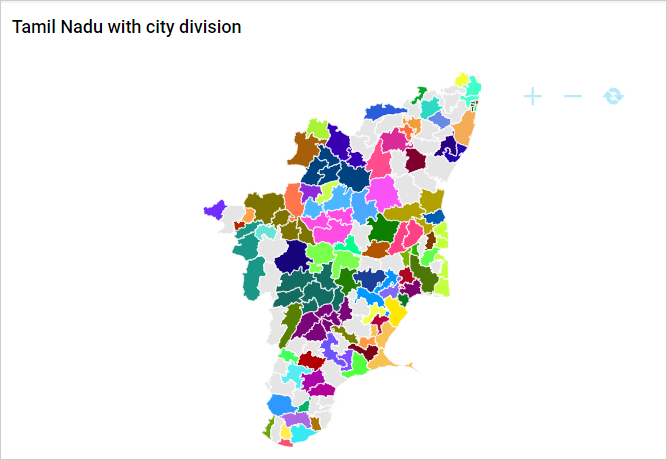
Drill up
Once you’ve drilled down, you can drill up to the previous view using the breadcrumb navigator located at the top of the widget.
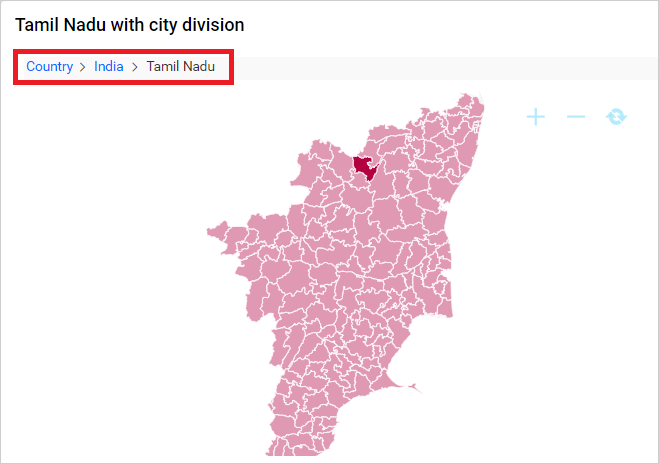
How to add customized shape in world map country
If you want to view the customized India shape while drilling India on the world map, follow these steps:
-
You should have customized the India shape files.
-
Open the
world_map_country.jsfile and search for India. -
Change the shape name to
Customindia.
-
Save it and refresh the dashboard. Configure the drill down with any data. Click the India shape on the world map, and the customized shape will be rendered.

Legend Settings
This section allows you to customize the legend in the map.

Show legend
This allows you to toggle the visibility of the legend in a map. By default, it will be enabled.
Type
It defines the legend type whether layers or marker.
- If Location Value and Location Name are configured without Marker Latitude and Longitude, the legend type will be Layers by default. In this case, the Type option will not be shown.

- If Marker Latitude and Longitude are bounded with advanced customization in the map without Location Name and Value configuration, the type will be Markers by default. In this case, the Type option will not be shown.
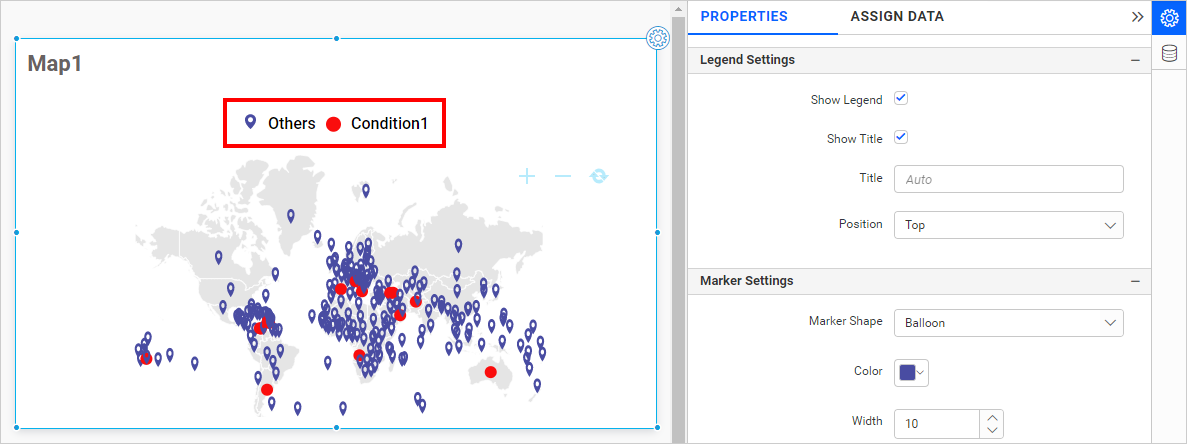
- If both Location Value and Location Name and Marker Latitude and Longitude with advanced customization are configured, the Type option will be shown in the
Legend Settings section. In this case, the legend will be shown based on the legend type.
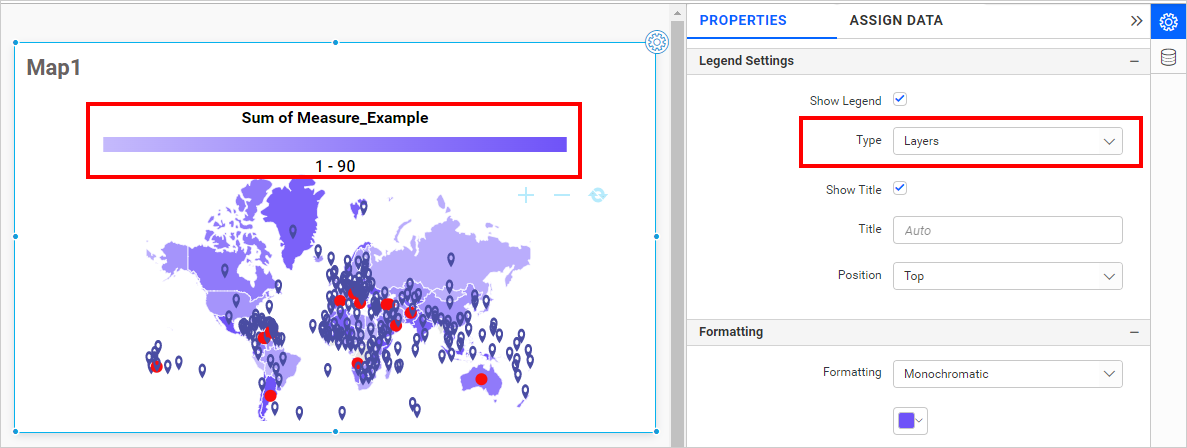
For type Markers, the legend will be shown as below.
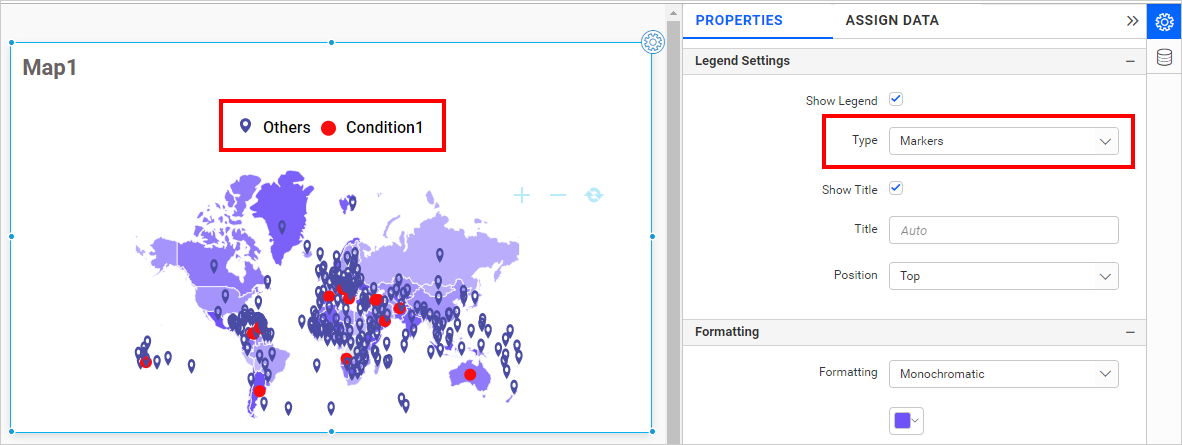
Show Title
This option allows you to toggle the visibility of the legend title in a map.
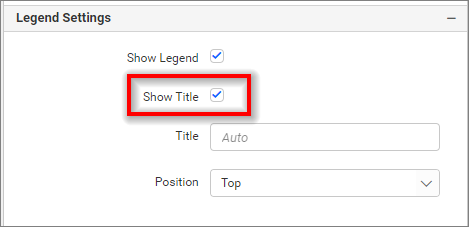
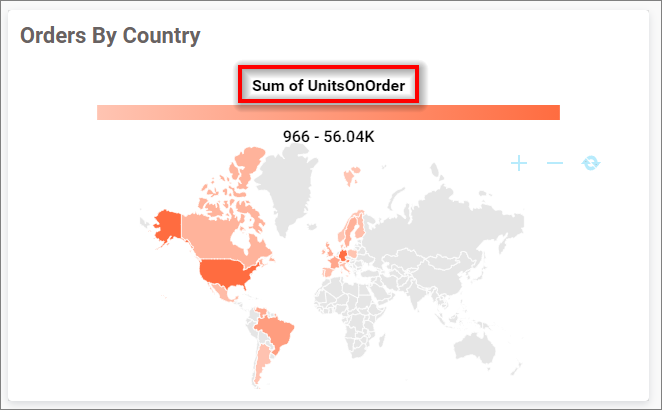
Title
This allows you to edit the legend title of a map.

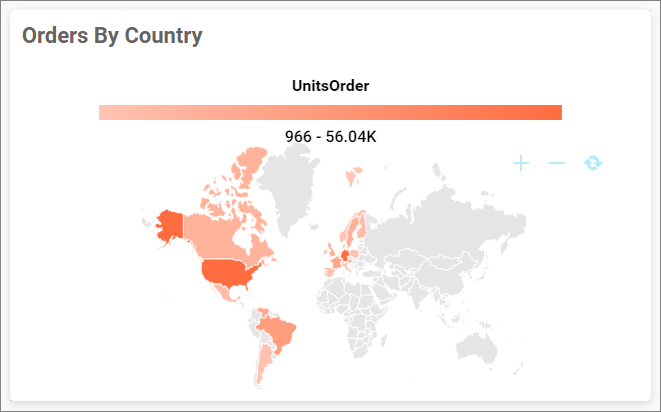
Position
This provides the option to select the legend placement in a map.
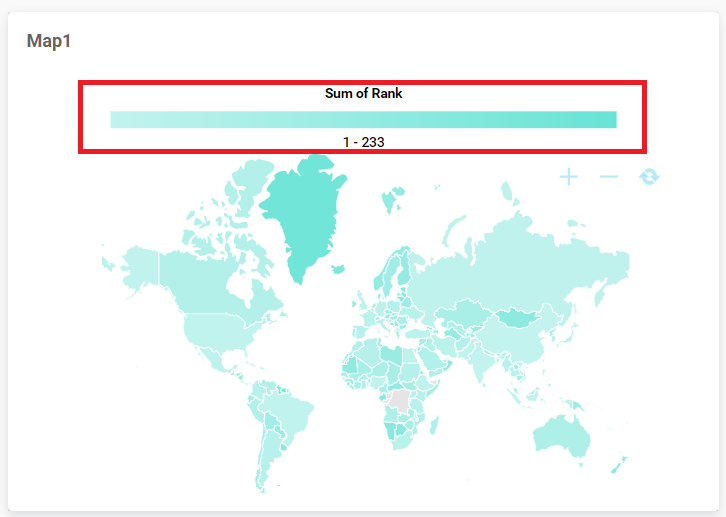
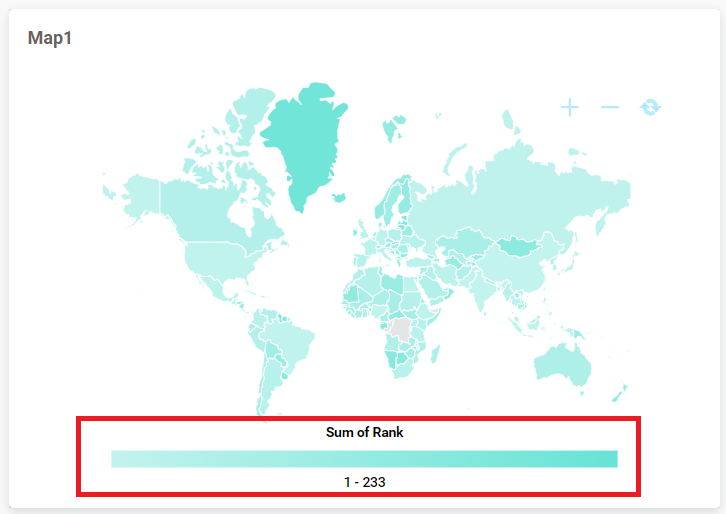
Marker Settings
If you bind the Marker latitude and Marker Longitude fields, the Marker settings category will be visible.

Marker Based Zoom
If you enable this option, the map will automatically zoom in to the marker area. Here, in the following map widget, the map has a single marker. It will be useful for the filtering process.
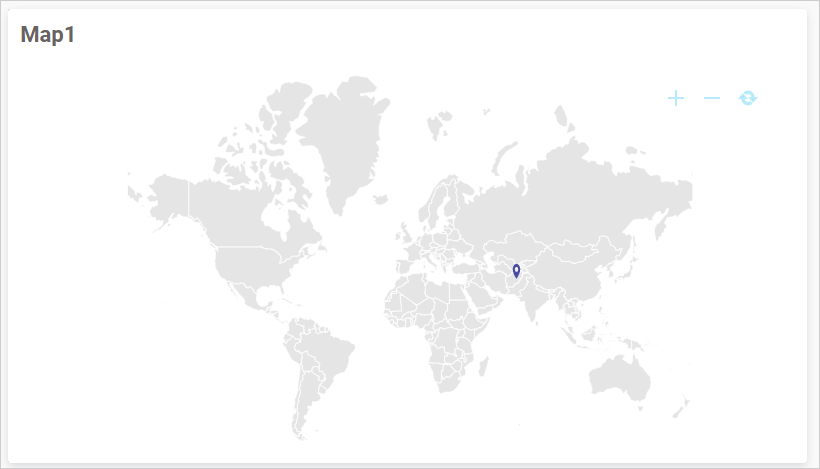
By enabling this option, the map will be zoomed in on the area where the marker is placed.
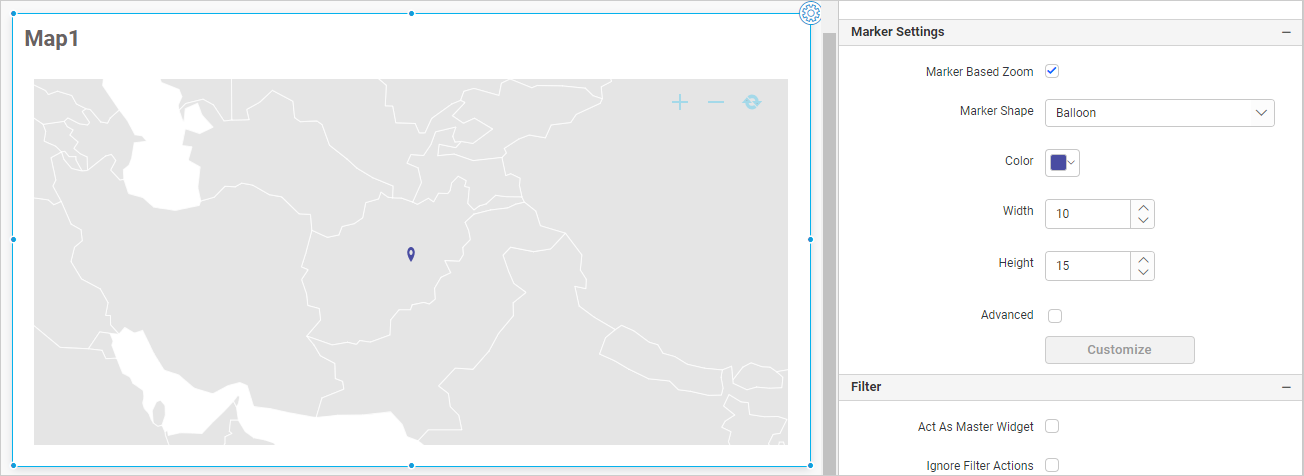
Marker Shape
This option allows you to customize the marker shape on the map.
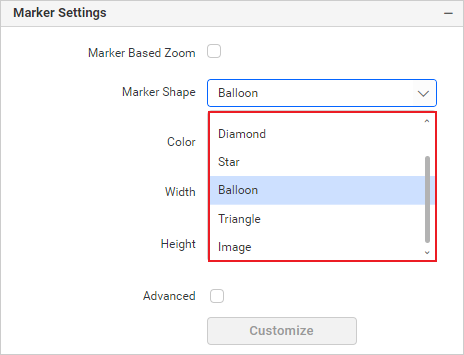
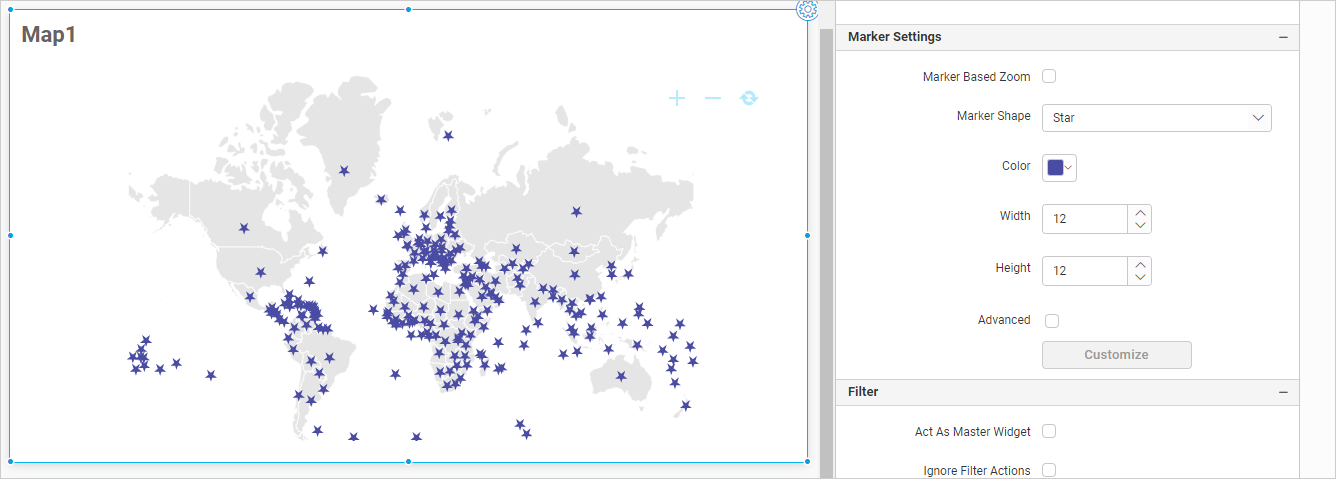
Color
This option allows you to customize the marker color.
Width
This option allows you to customize the marker width. When configuring data into Marker size, this property will be disabled.
Height
This option allows you to customize the marker height. When configuring data into Marker size, this property will be disabled.
Advanced
Rule
This option allows you to customize the map marker.
If you enable the Advanced option, the color customization window will render as follows:
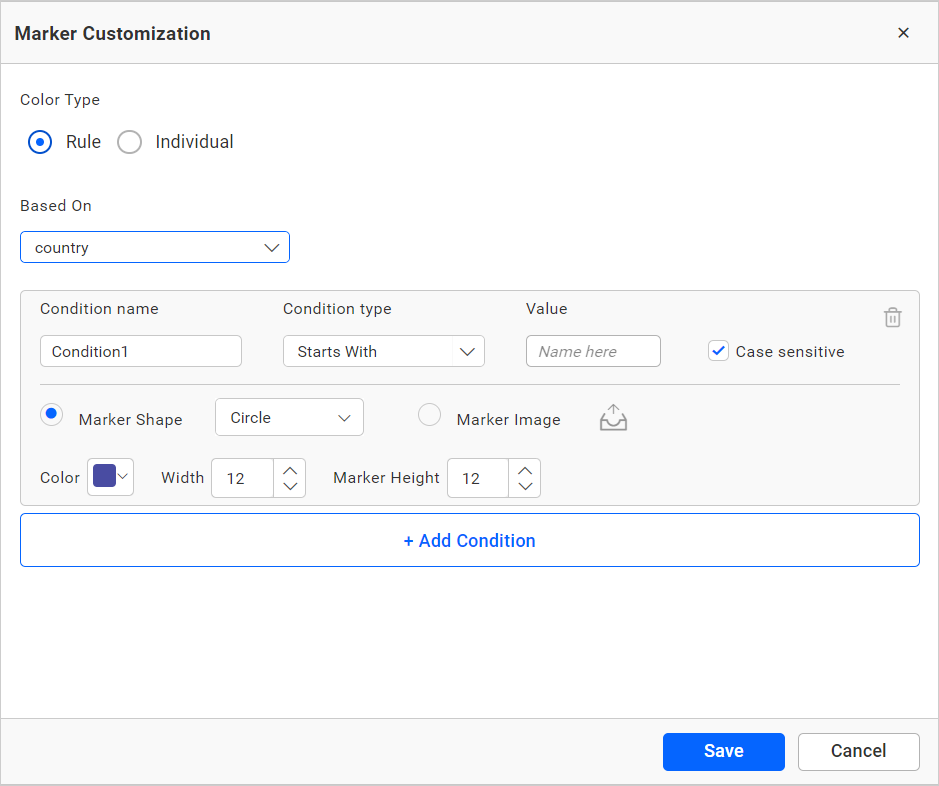
You can change based on the field and summary type.
You can choose a series of colors with the Color color picker using multiple condition sets for measure value: greater than, less than, equal to, not equal to, between, not between, greater than or equal to, less than or equal to. For Dimension values: starts with, ends with, contains, not contains, equals, not equals. You can customize the width and height of the marker.
You can customize the shape of the marker with the Marker Shape option or you can customize the shape as an image with the Marker Image option. You can also customize the legend name by providing the necessary values inside the condition name and you can also add multiple conditions.
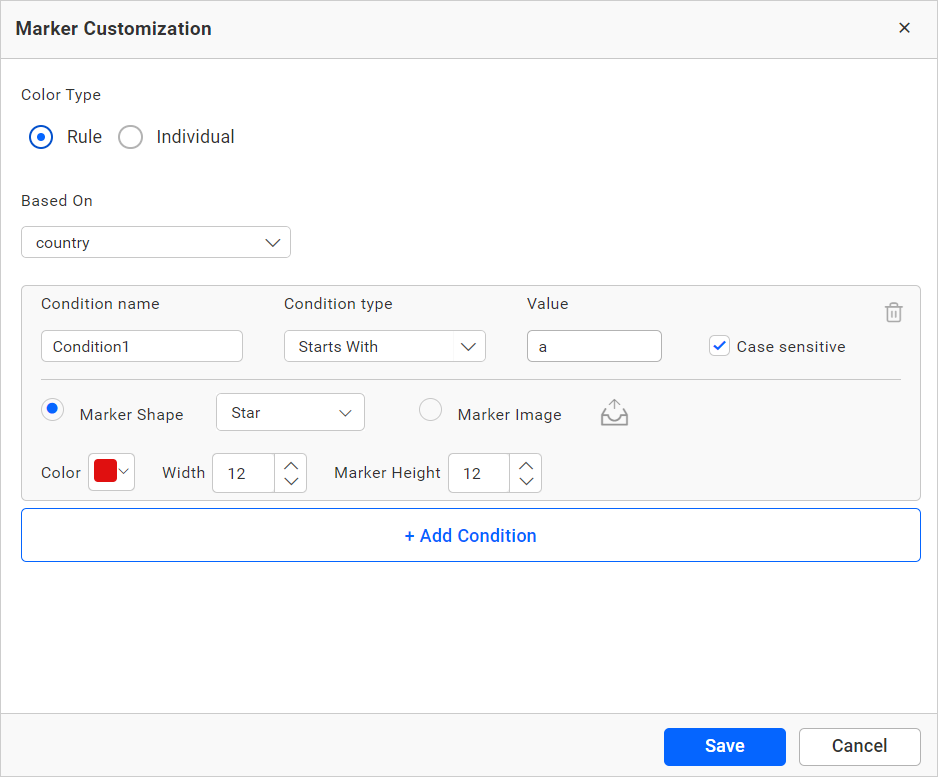
If you click save, the map widget will render like this:
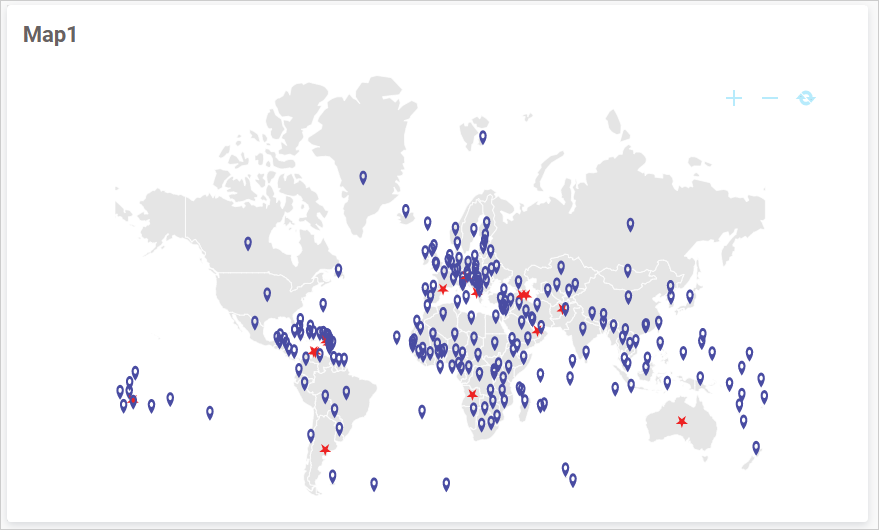
Individual
This option allows you to customize the map marker color individually based on the selected column values.
For example, if you have three types of signal strength options in your data and you want to display marker colors based on the three types, you can select the Signal Strength column in the based selection and then assign a color for each type of signal strength option.

Now, the map marker color renders with these changes.
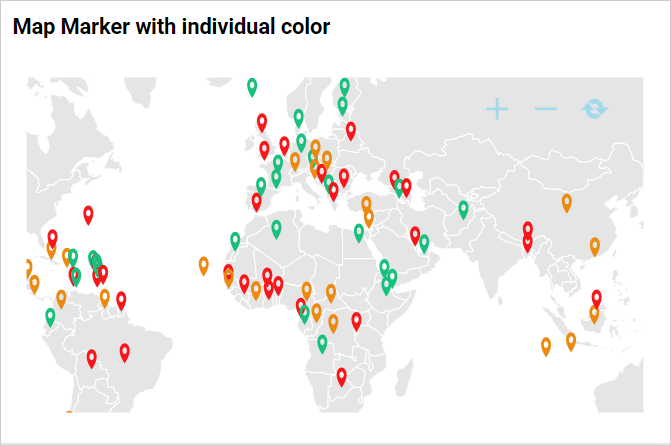
Link
You can enable linking and configure to navigate to a general URL with or without parameters. For more details, refer to the Linking.

Formatting
This section shows up when the Location Value and Location Name fields have values.

Monochromatic
You can configure a single color palette whose saturation differs based on the value density.


Advanced Settings
This allows you to customize the map color with three different types: gradient, rule, or individual. By default, the window renders with gradient type.
If you enable the option Advanced, the color customization window will render as follows.


Gradient
You can select based on which field to apply gradient color by the Based On dropdown. You can change the summary type. You can edit the Low and the High value and their colors. By default, the low value takes the minimum value of the map and the high value takes the maximum value of the map. Mid can be enabled and can change its value and color can be changed. By default, mid-color is disabled.
If you click save, the map will render as follows.
Choropleth map
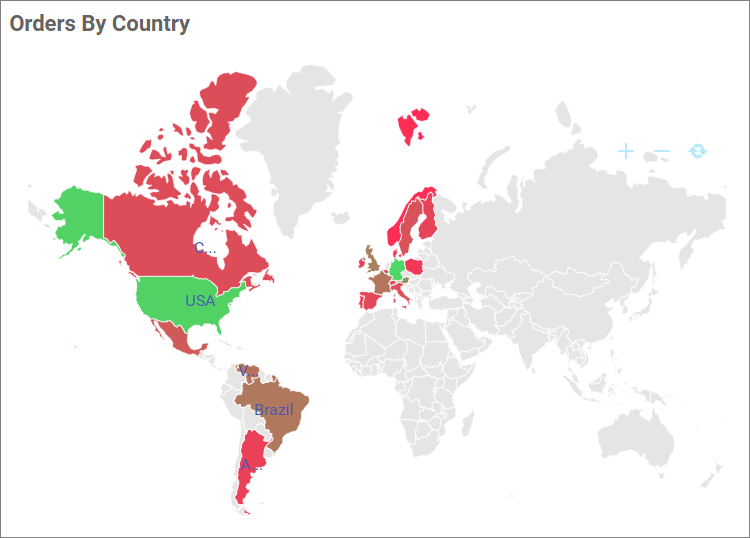
Bubble map

Default color

The default color will apply for the conditions that are not satisfied by the advance color customization.
Rule
You can select the rule settings by clicking the Rule radio button. The color customization window renders as follows.
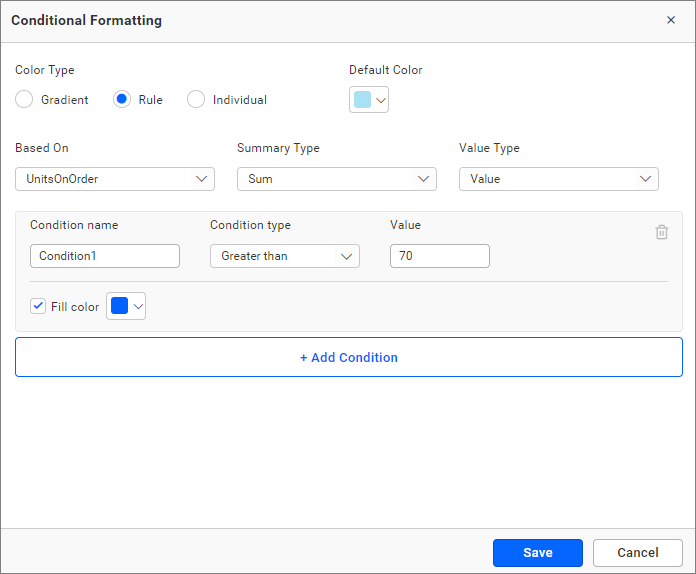
You can change based on field and summary type as gradient type. The Value Type can be change with value or percentage.
You can choose a series of colors with the Fill color picker using multiple condition sets: greater than, less than, equal to, not equal to, between, Not between, greater than or equal to, less than or equal to. You can customize the legend name by providing necessary values inside condition name. You can also add multiple conditions.

If you click save the map widget will render like this.
Choropleth map
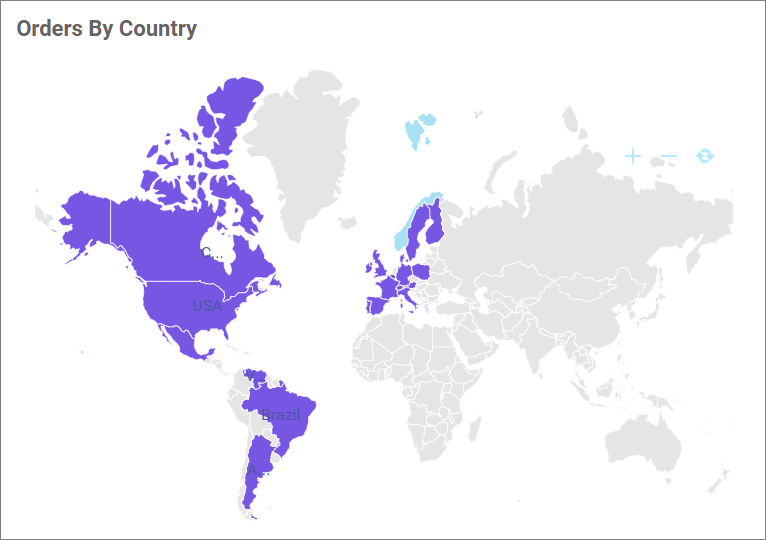
Bubble map
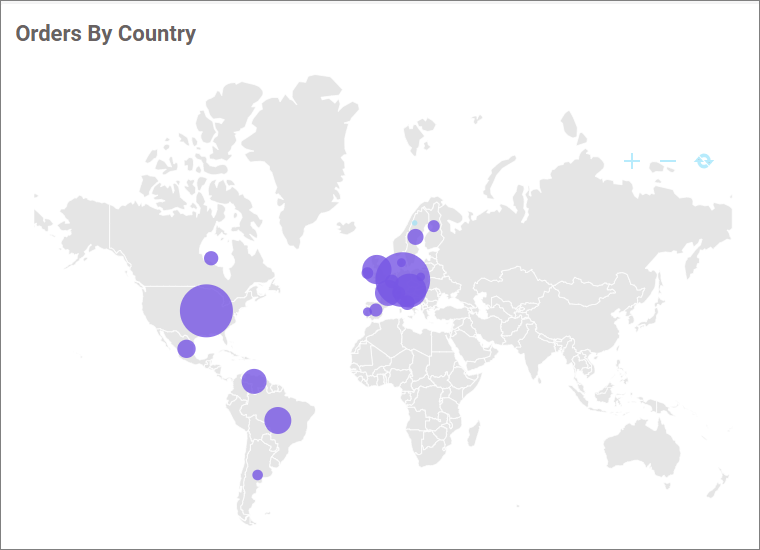
Individual
You can select the rule settings by clicking the Individual radio button. The color customization window renders like this.
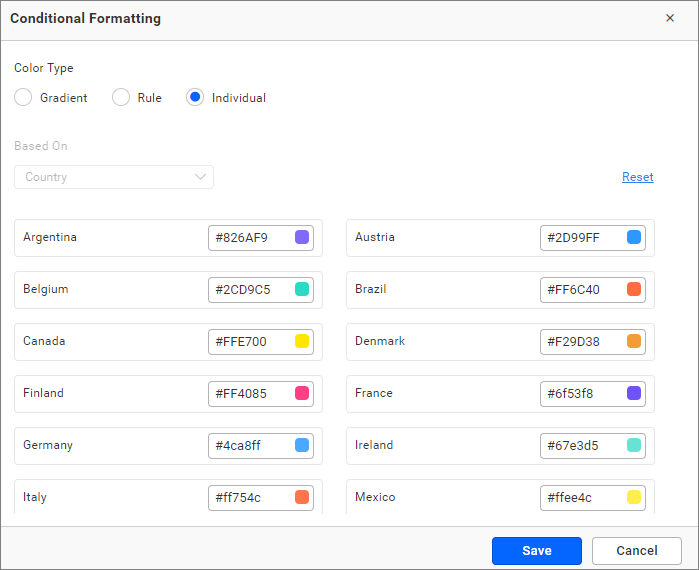
This type renders with the individual default color for each value of the map. You can change its color with individual color pickers. If you want to reset your changes return to the default color with Reset.
You can save your changes by clicking Save. Now, the map renders with changes.
Choropleth map
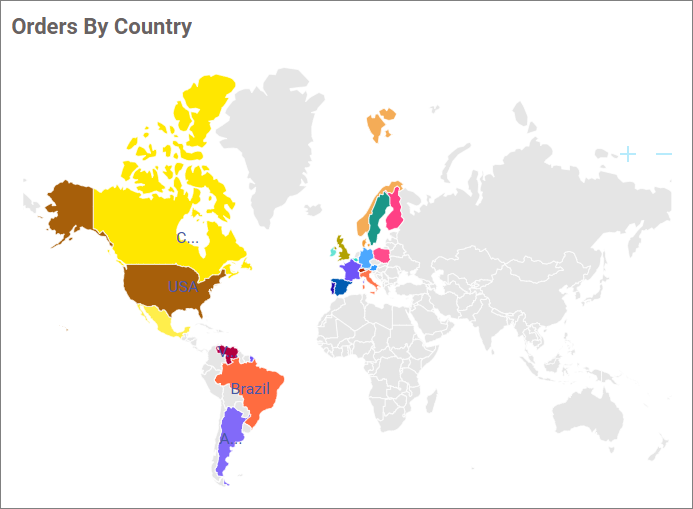
Bubble map
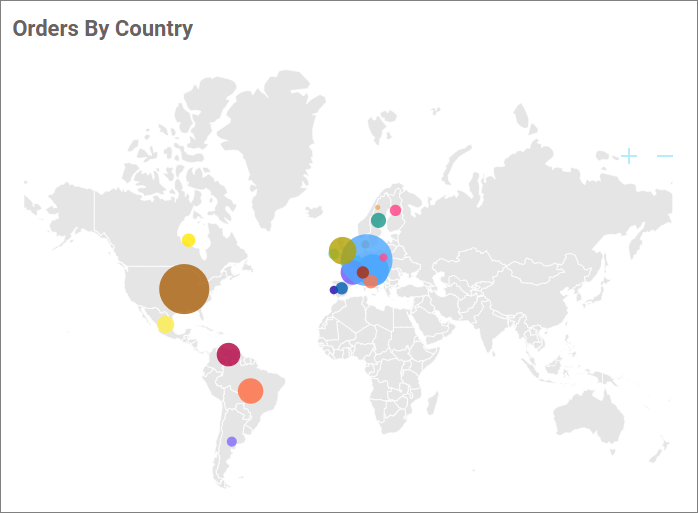
Font settings
This section allows you to customize the font size of map elements.
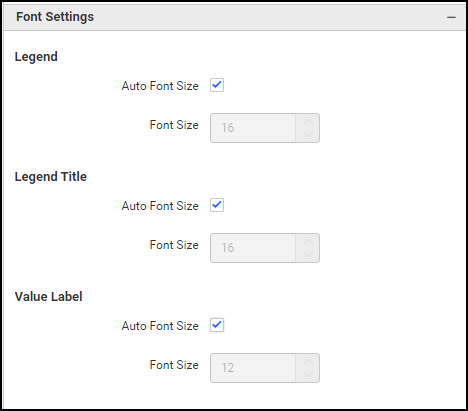
Auto Font Size and Font Size
By default, the ‘Auto Font Size’ property is enabled. The Auto Font Size property is used to set Font Size based on dashboard viewing client machine resolution.
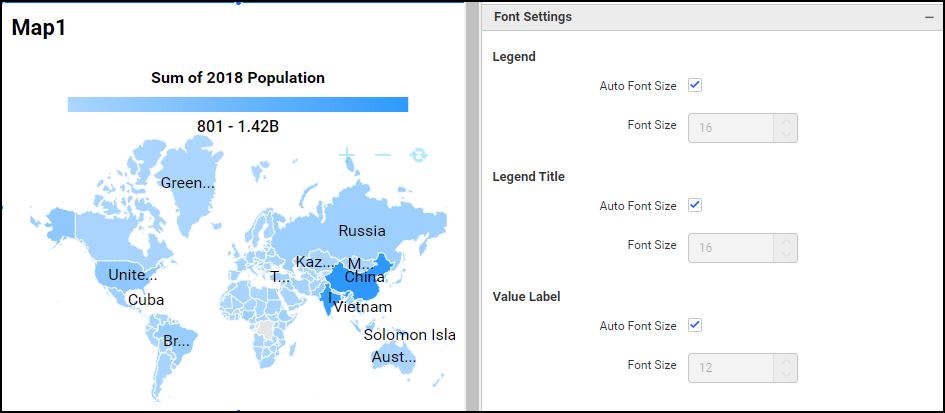
If the user wants to customize or set a Fixed Font Size, the user needs to disable Auto Font Size and set the required Font Size. In the image below, I have set different font sizes for Legend, Legend Title, and Value Label.
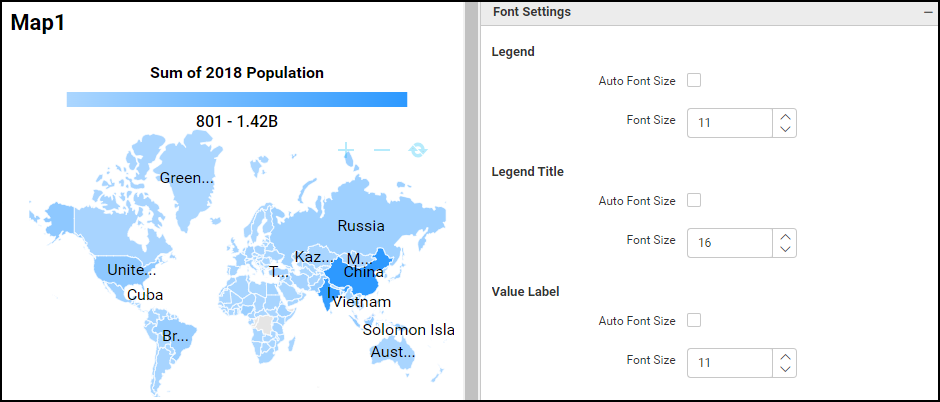
Filter

Act as Master Widget
This allows you to define the map widget as a master widget such that its filter action can be made to listen by other widgets in the dashboard.
Select a shape to filter interaction, the menu will be shown as follows.

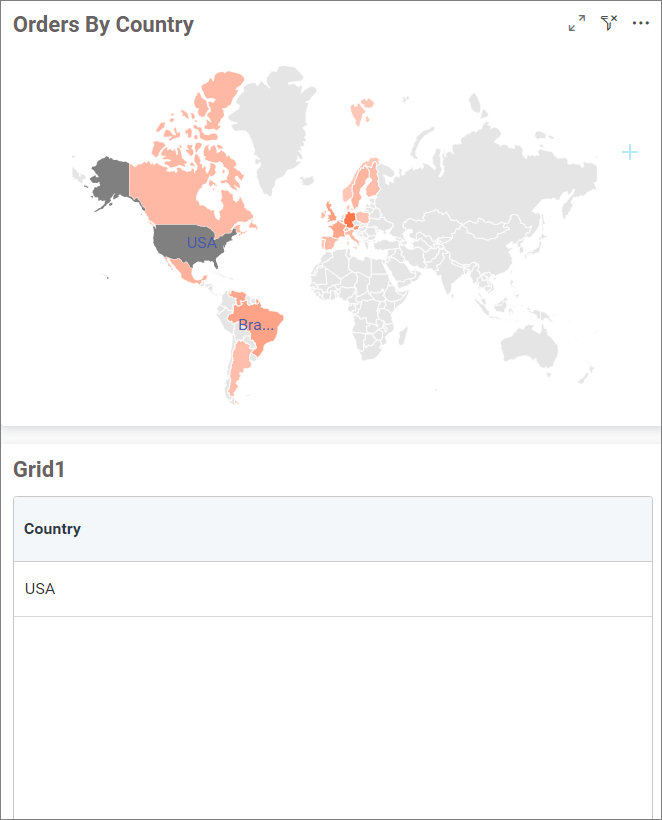
If you enable Act as Mater Widget option, Enable Multi Selection will be shown.

This option allows using multiple filter interactions.
Consider if you clicked one shape in the map widget already, then click another shape and select the Filtering option on the menu. Now, the slave widget will respond like this.
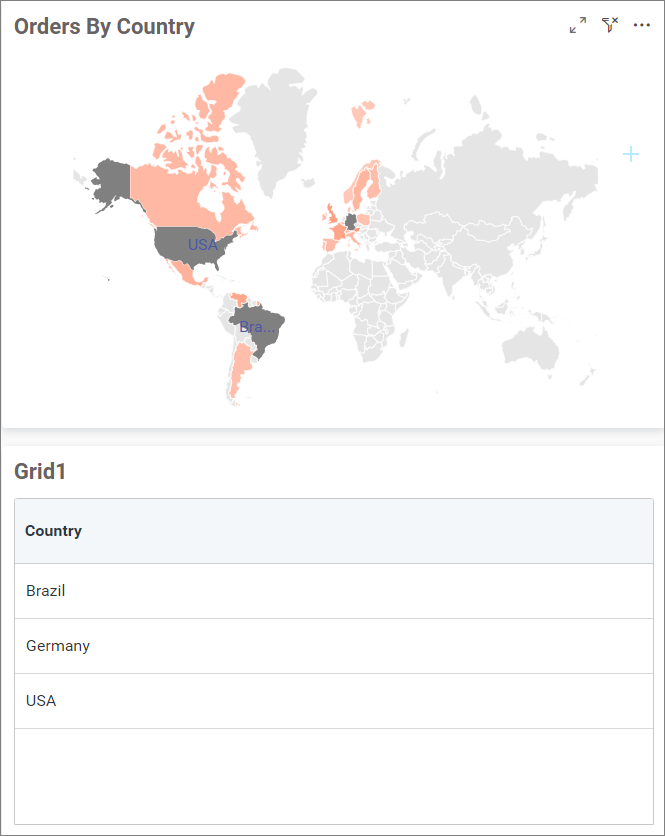
Ignore filter actions
It defines the map widget to ignore the filter actions applied to other widgets in the dashboard.
Enable Hierarchical Filter
Through this option, you can enable or disable hierarchical the Top N filtering. While applying the Top N filter with multiple dimension columns, the data returned can be customized based on whether the filtering needs to be done as flat or based on the hierarchy of added dimension columns.
When the Hierarchical Filter option is enabled, the Top N will be applied for each individual column separately based on the number set for each column.
Container Appearance
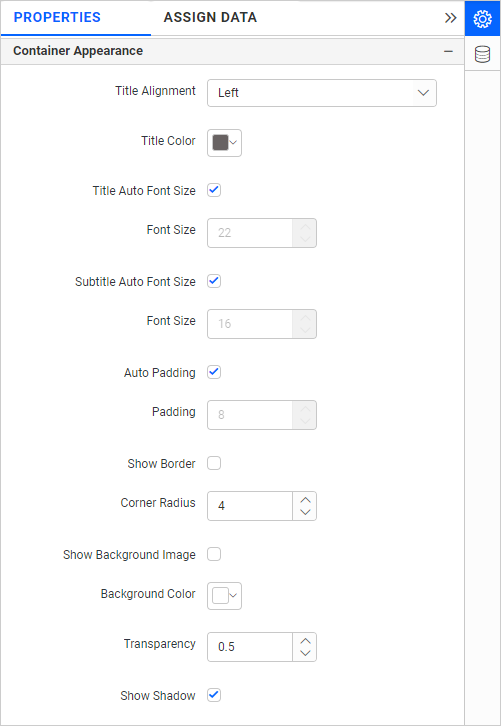
Title Alignment
This allows you to handle the alignment of widget title to either left, center, or right.
Title Color
This allows you to apply the text color to the widget title.
Title Auto Font Size
On enabling Auto Font Size, the font size of the title will be adjusted automatically if the resolution of the screen varies.
Font Size
This allows you to apply the specified size of the font to the widget title if the Title Auto Font Size is disabled. Value can be between 10 and 44.
Subtitle Auto Font Size
On enabling Auto Font Size, the font size of the subtitle will be adjusted automatically if the resolution of the screen varies.
Font Size
This allows you to apply the specified size of the font to the widget title if the Subtitle Auto Font Size is disabled. Value can be between 10 and 32.
Auto Padding
On enabling Auto Padding, the padding of the widget container will be adjusted automatically if the size of the widget varies.
Padding
This allows you to customize the padding of the widget container if the Auto Padding is disabled. Value can be between 0 and 25.
Show Border
This allows you to toggle the visibility of the border surrounding the widget.
Corner Radius
This allows you to apply the specified radius to the widget corners if the Show Border is enabled. Value can be between 0 and 10.
Show Background Image
This allow you to set the background image for the map widget.
Background Color
This allows you to set the background color to the map widget.
Transparency
This property allows you to change the transparency from 0.0 to 1.0.
Show Shadow
This allows you to toggle the visibility of the shadow surrounding the widget.
Container actions
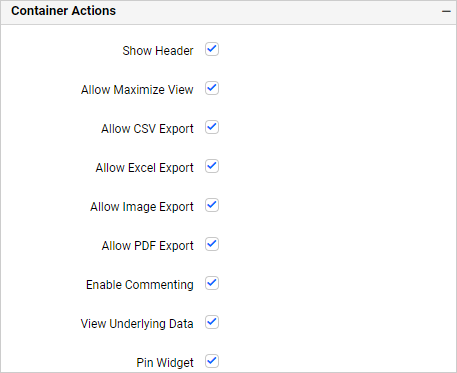
Show Header
This allows you to enable or disable the widget title of the map.
Allow Maximize View
This allows you to enable or disable the maximized mode of the map widget. The visibility of the maximize icon in the widget header will be defined based on the setting in the viewer.
Allow CSV Export
This allows you to enable or disable the CSV export option for the map widget. Enabling this allows you to export the summarized data of the widget view to CSV format in the viewer.
Allow Excel Export
This allows you to enable or disable the Excel export option for the map widget. Enabling this allows you to export the summarized data of the widget view to (.xlsx or .xls) format in the viewer.
Allow Image Export
This allows you to enable or disable the Image export option for the map widget. Enabling this allows you to export the view of the widget to image format (.jpg), (.png), or (.bmp) in the viewer.
Allow PDF Export
This allows you to enable or disable the PDF export option for the map widget. Enabling this allows you to export the view of the widget to pdf format in the viewer.
Enable Comments
This allows you to enable or disable comment for the dashboard widget. For more details, refer to the Commenting Widget.
Allow View Underlying Data
This allows you to visualize the raw data associated with a widget at runtime.
To learn more about viewing the underlying widget data, refer to the view data documentation.
Pin Widget
This allows you to pin the widget.
Responsive Behavior
We hide the widget elements based on the size of the widget for better readability.
When the map has been placed with less than 7 rows map legend will be hidden.

- Choropleth map
- Bubble map
- How to change map type as choropleth or bubble
- How to configure the table data into a map
- Marker Size
- Hidden Column
- Linking
- Filtering
- View Data
- How to format a map
- General Settings
- Name
- Subtitle
- Description
- Basic settings
- Show Tooltip
- Map type
- Show legend
- Enable Zooming
- Show Label
- Label Color
- Enable Multi Selection
- Shape kind
- Shape data
- How to add new shape files
- Drill down configuration
- Drill up
- How to add customized shape in world map country
- Legend Settings
- Show legend
- Type
- Show Title
- Title
- Position
- Marker Settings
- Marker Based Zoom
- Marker Shape
- Color
- Width
- Height
- Advanced
- Rule
- Individual
- Link
- Formatting
- Monochromatic
- Advanced Settings
- Gradient
- Default color
- Rule
- Individual
- Font settings
- Auto Font Size and Font Size
- Filter
- Act as Master Widget
- Ignore filter actions
- Enable Hierarchical Filter
- Container Appearance
- Title Alignment
- Title Color
- Title Auto Font Size
- Subtitle Auto Font Size
- Auto Padding
- Show Border
- Corner Radius
- Show Background Image
- Background Color
- Transparency
- Show Shadow
- Container actions
- Show Header
- Allow Maximize View
- Allow CSV Export
- Allow Excel Export
- Allow Image Export
- Allow PDF Export
- Enable Comments
- Allow View Underlying Data
- Pin Widget
- Responsive Behavior
- Choropleth map
- Bubble map
- How to change map type as choropleth or bubble
- How to configure the table data into a map
- Marker Size
- Hidden Column
- Linking
- Filtering
- View Data
- How to format a map
- General Settings
- Name
- Subtitle
- Description
- Basic settings
- Show Tooltip
- Map type
- Show legend
- Enable Zooming
- Show Label
- Label Color
- Enable Multi Selection
- Shape kind
- Shape data
- How to add new shape files
- Drill down configuration
- Drill up
- How to add customized shape in world map country
- Legend Settings
- Show legend
- Type
- Show Title
- Title
- Position
- Marker Settings
- Marker Based Zoom
- Marker Shape
- Color
- Width
- Height
- Advanced
- Rule
- Individual
- Link
- Formatting
- Monochromatic
- Advanced Settings
- Gradient
- Default color
- Rule
- Individual
- Font settings
- Auto Font Size and Font Size
- Filter
- Act as Master Widget
- Ignore filter actions
- Enable Hierarchical Filter
- Container Appearance
- Title Alignment
- Title Color
- Title Auto Font Size
- Subtitle Auto Font Size
- Auto Padding
- Show Border
- Corner Radius
- Show Background Image
- Background Color
- Transparency
- Show Shadow
- Container actions
- Show Header
- Allow Maximize View
- Allow CSV Export
- Allow Excel Export
- Allow Image Export
- Allow PDF Export
- Enable Comments
- Allow View Underlying Data
- Pin Widget
- Responsive Behavior